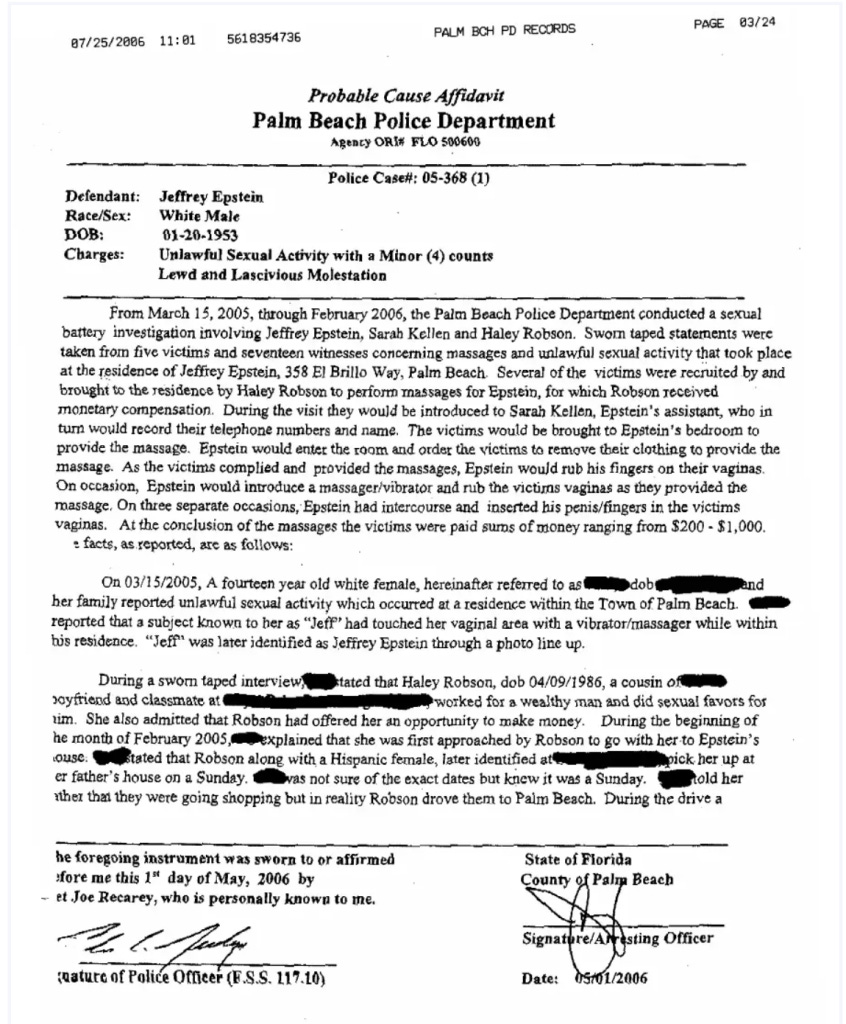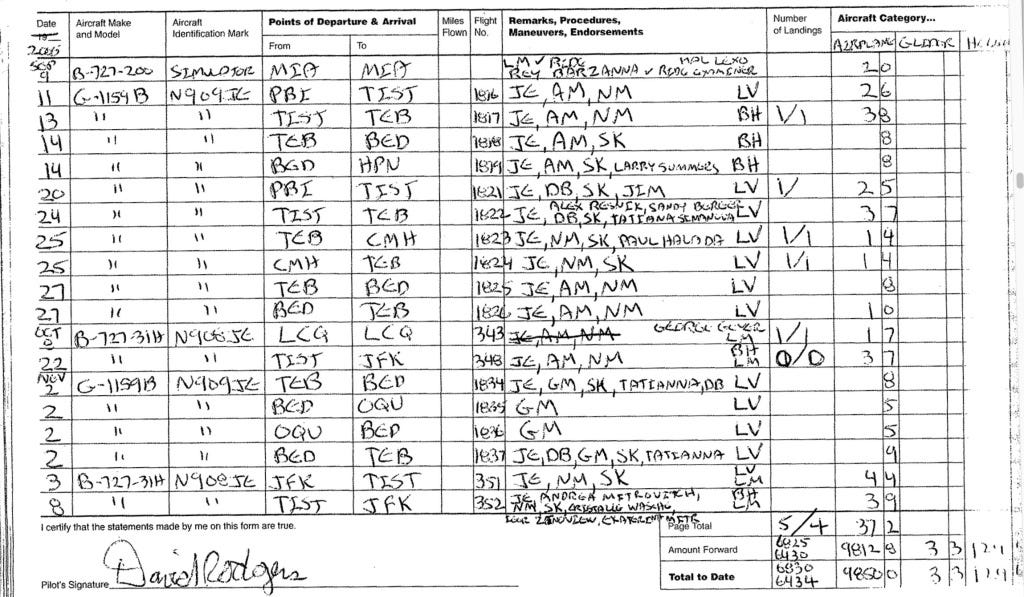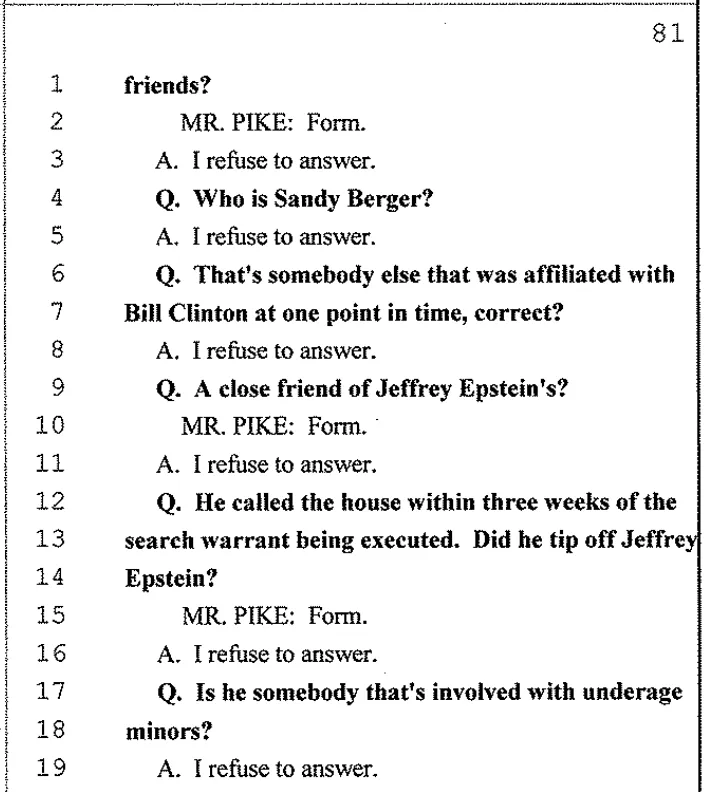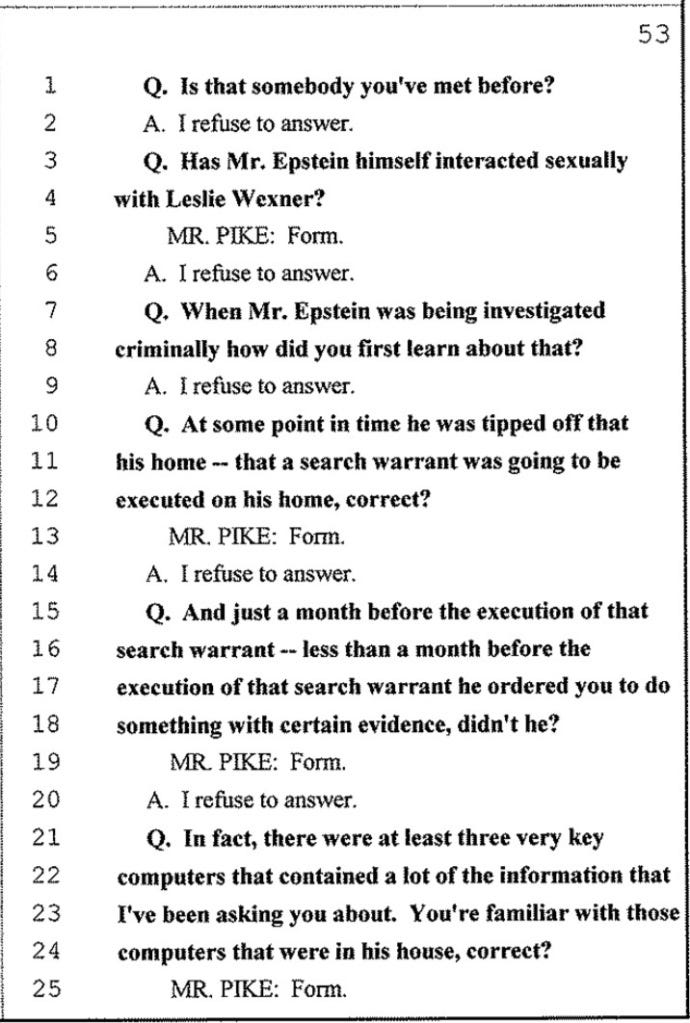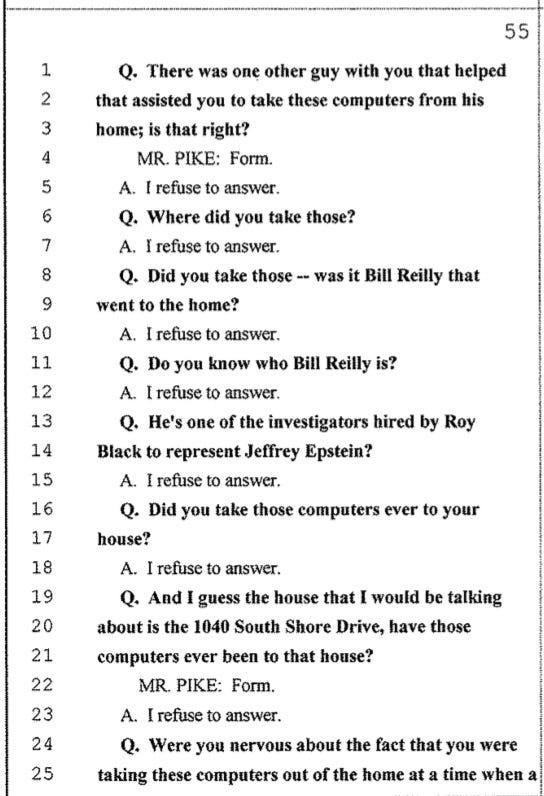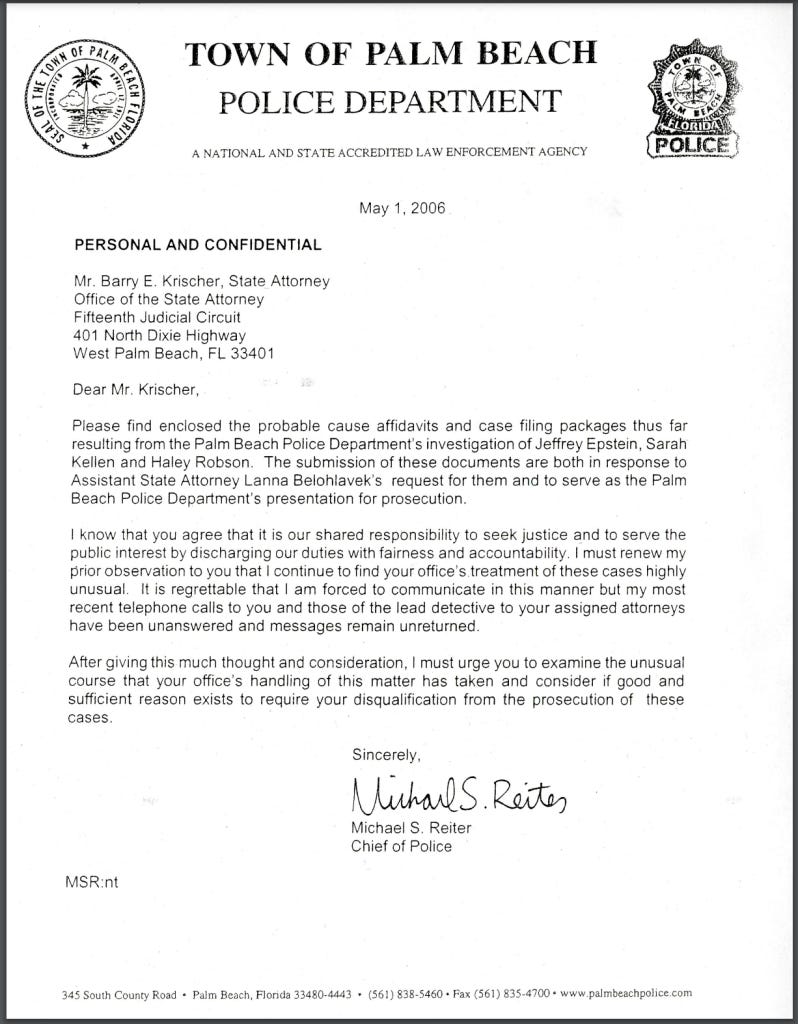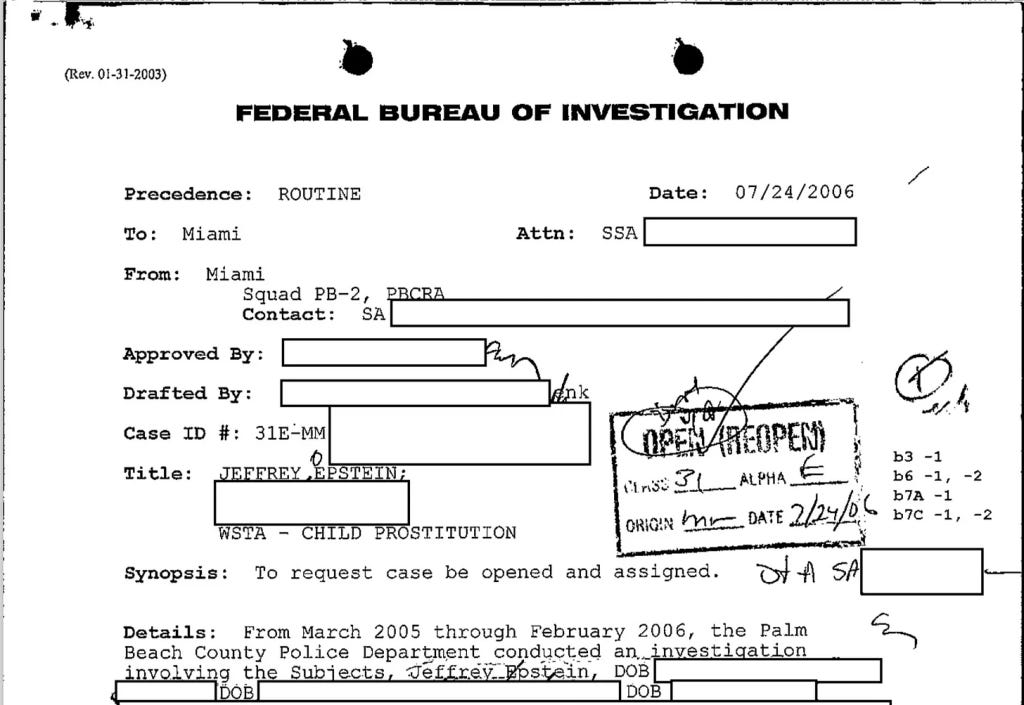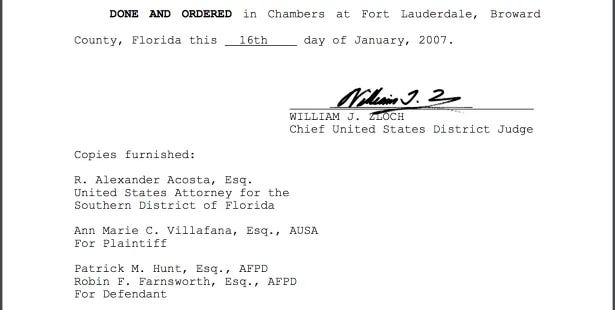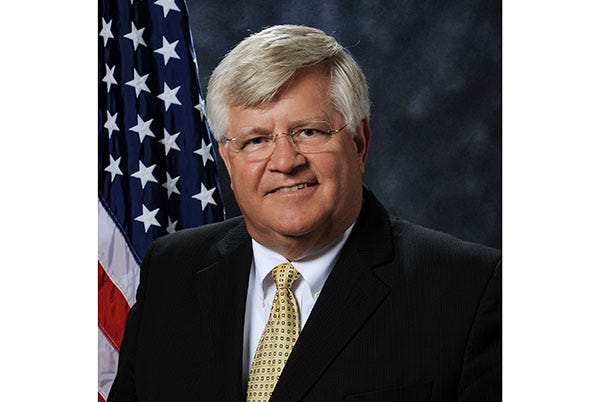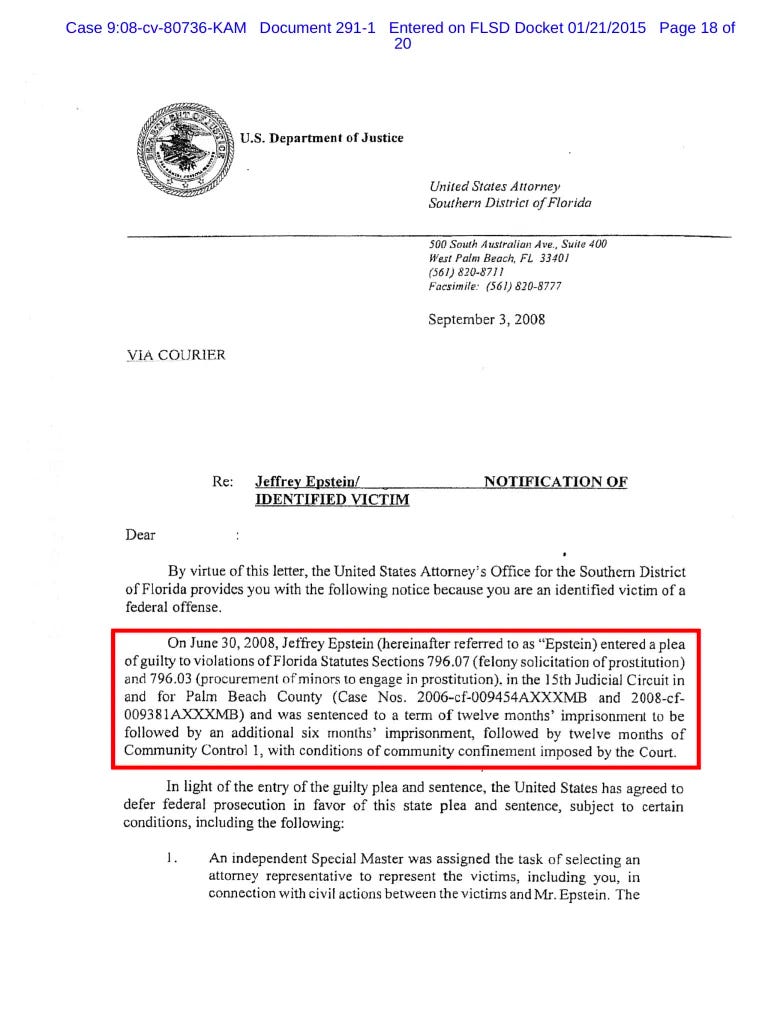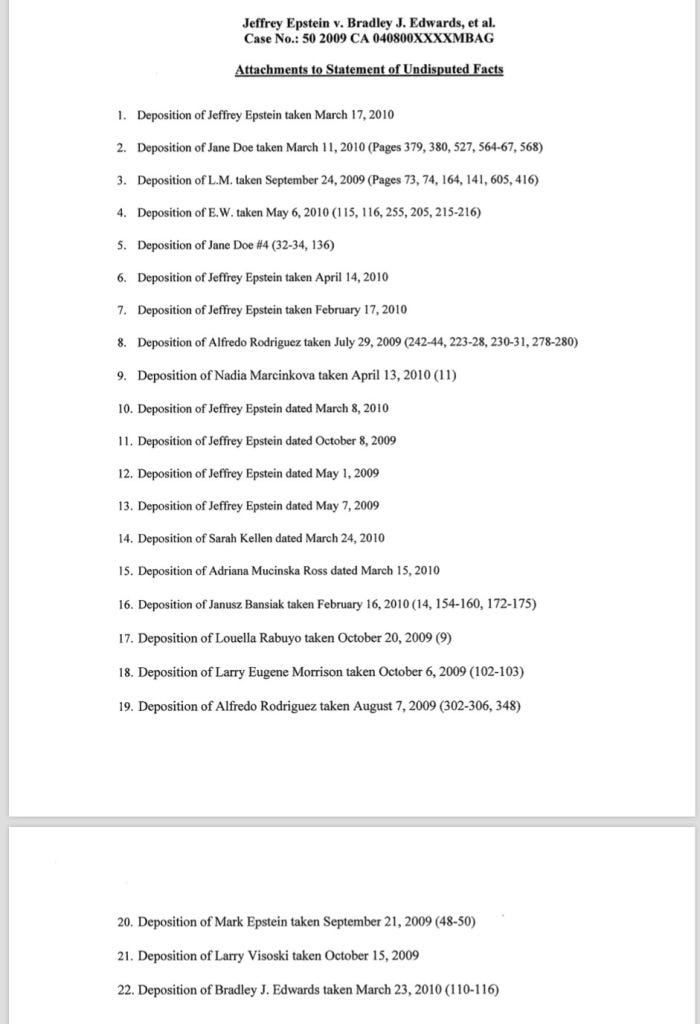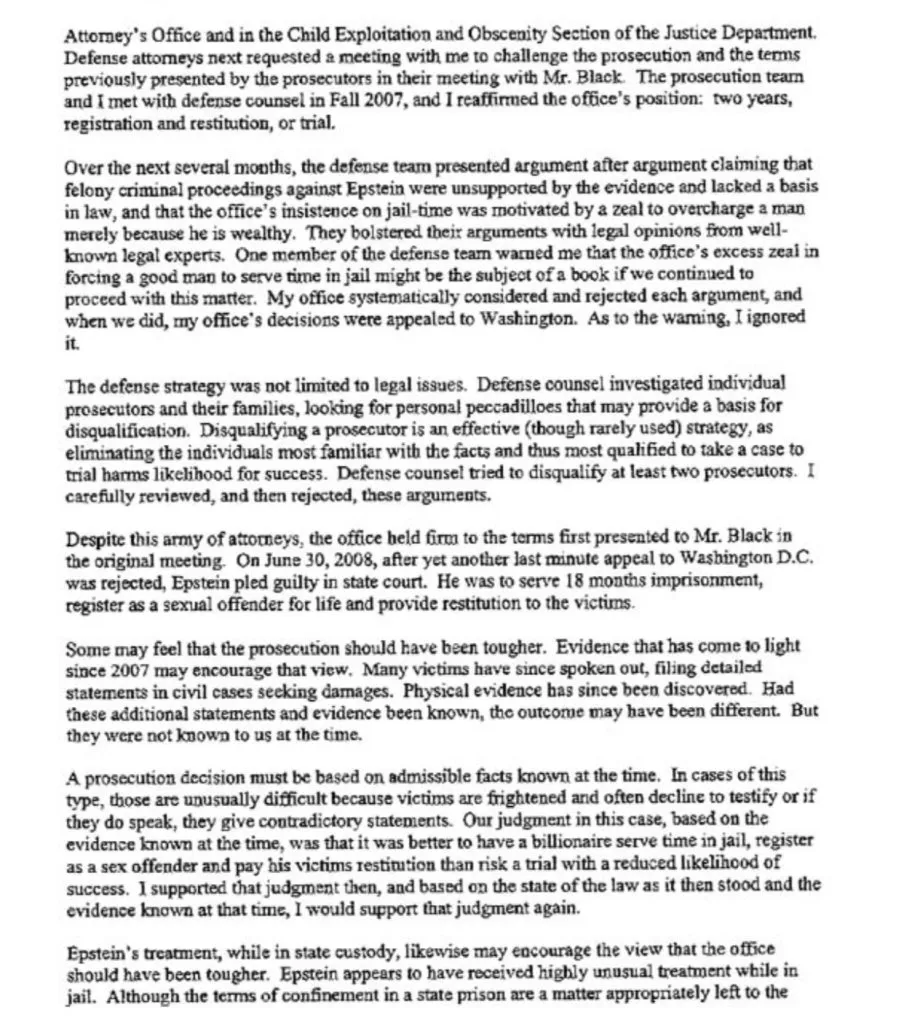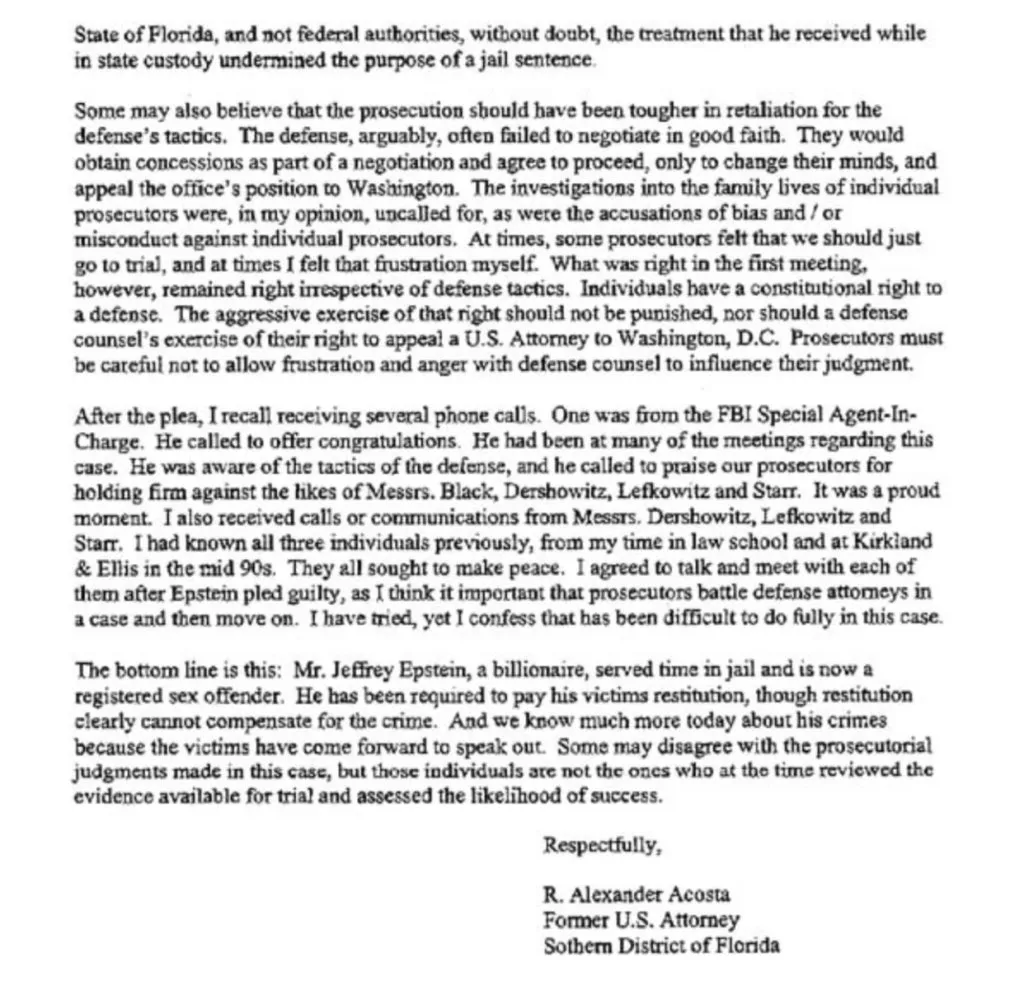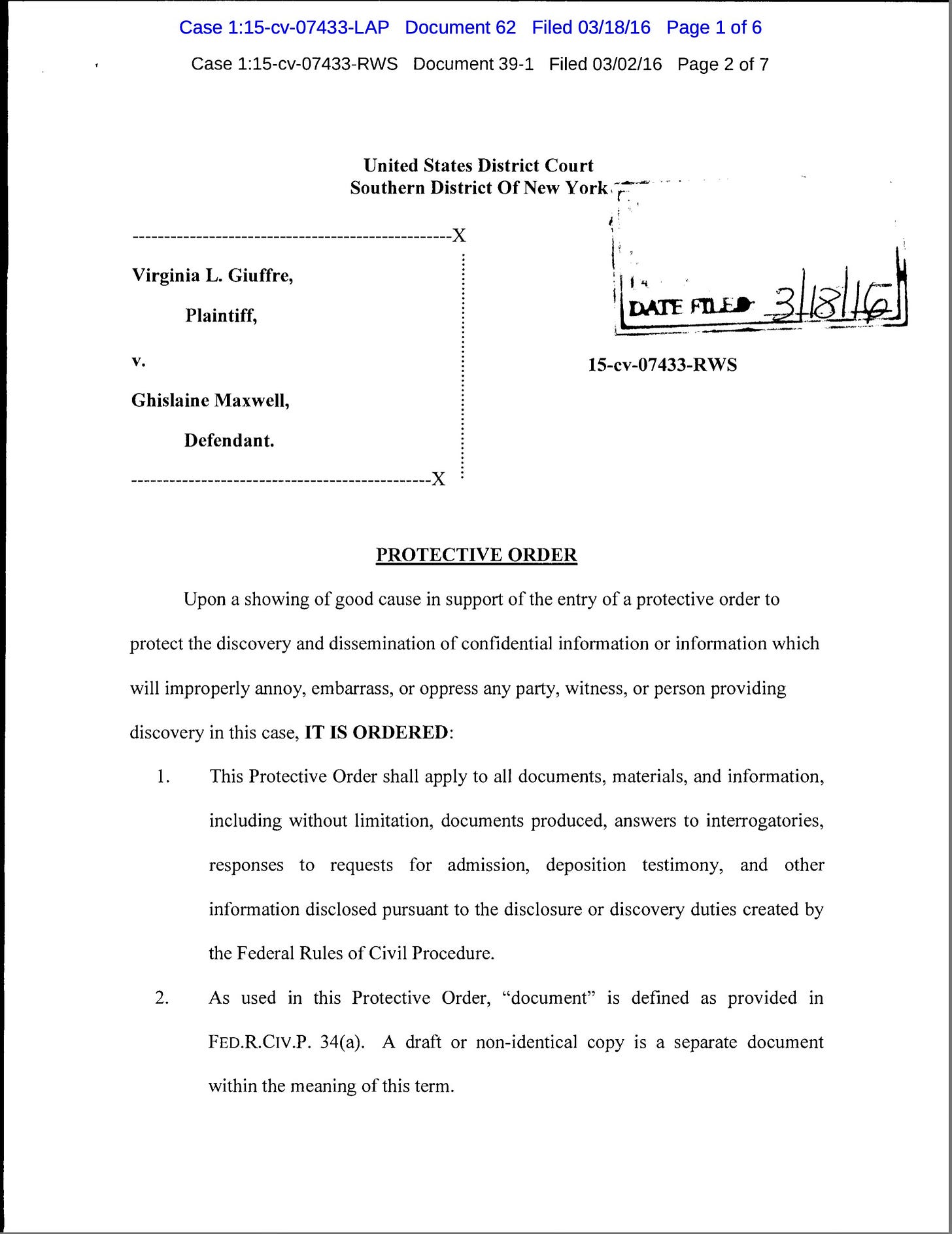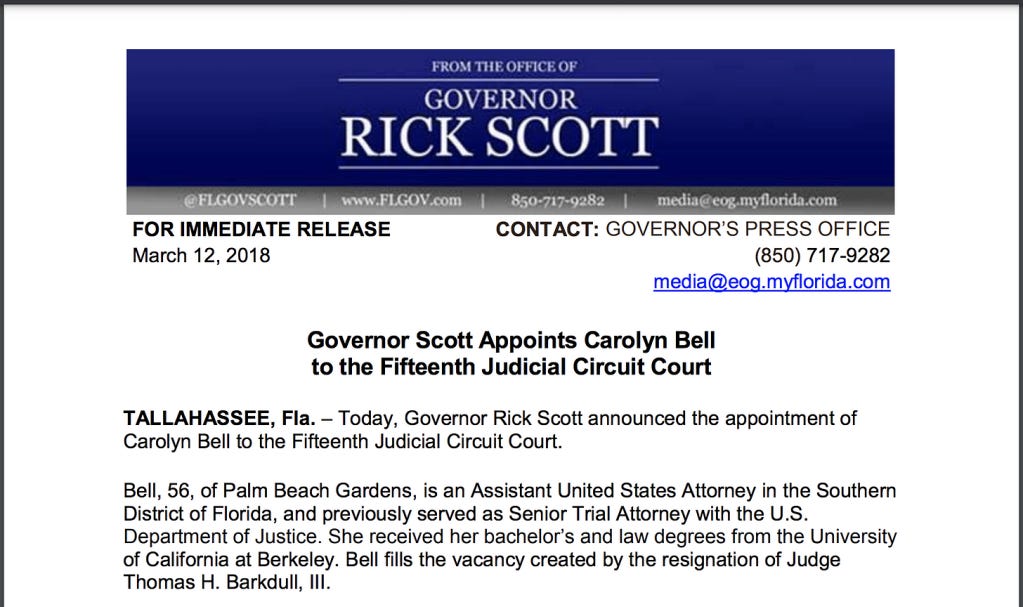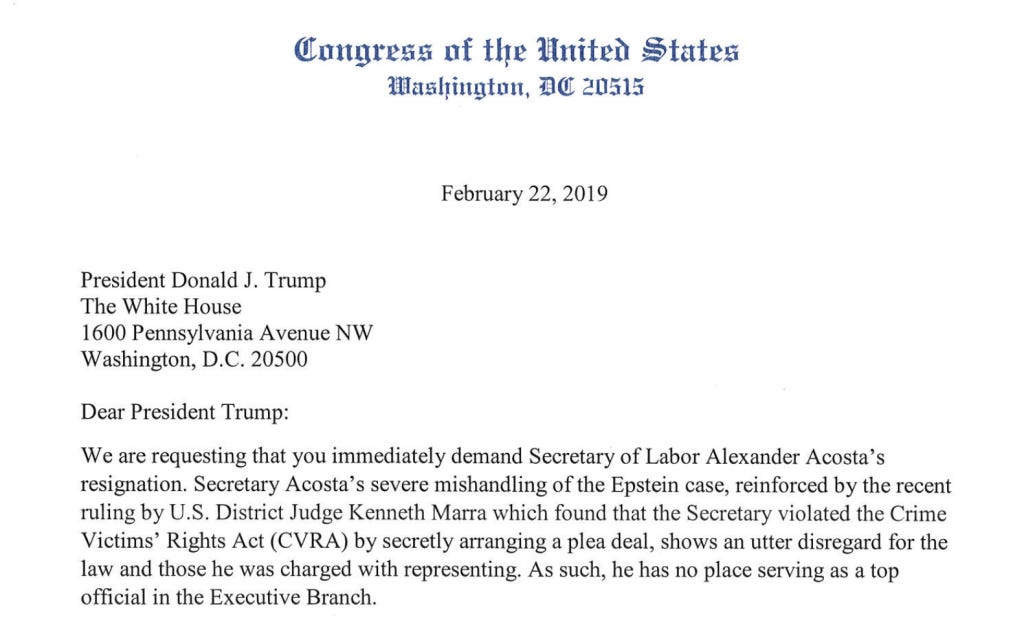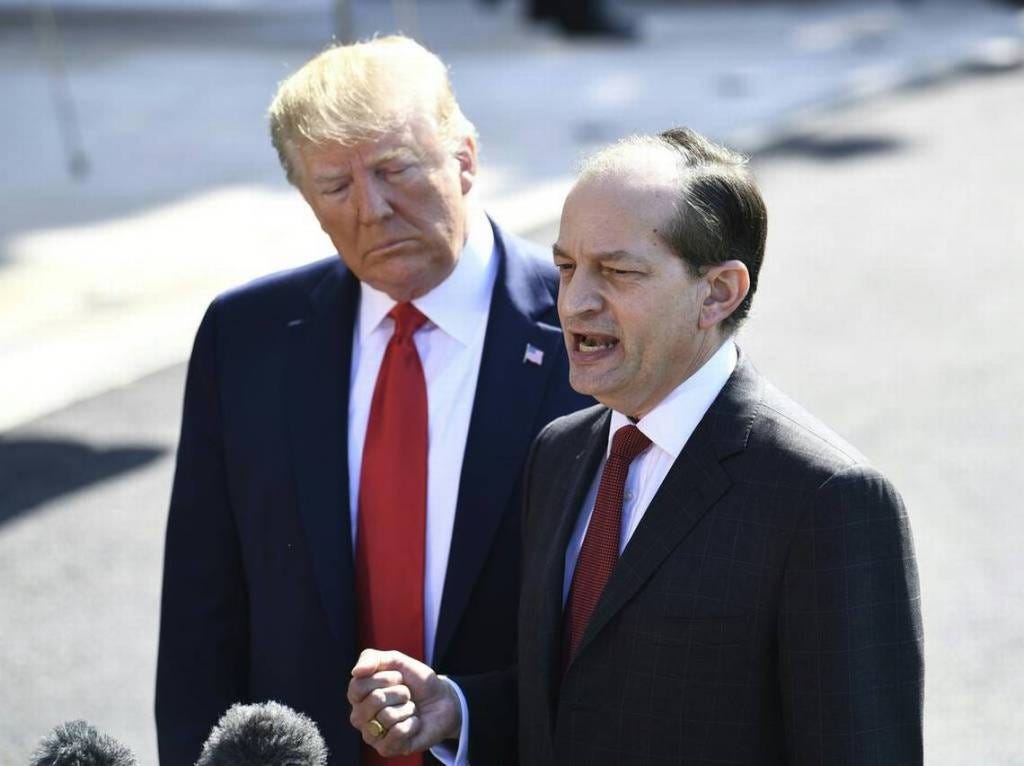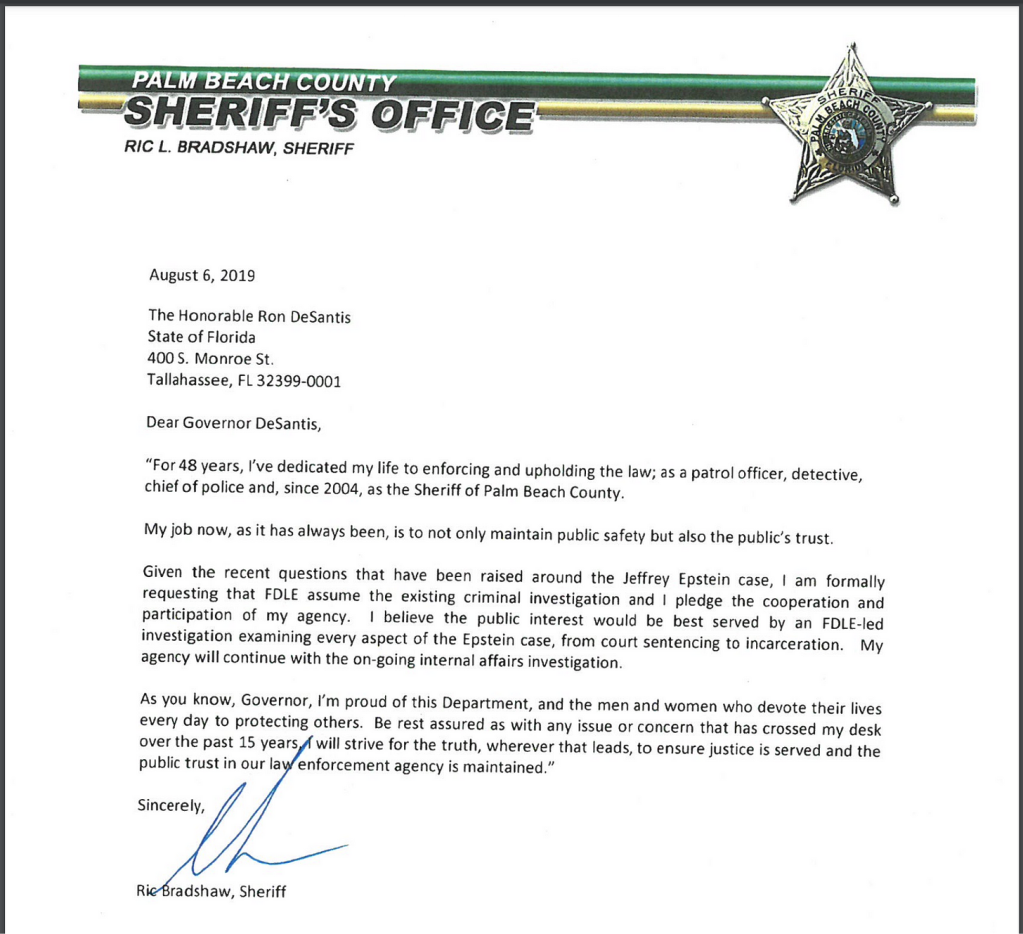This research effort originally began as an effort to summarize what exactly is wrong with the appointment of Bruce Reinhart to be a Magistrate Judge in the US District of South Florida. There is nothing that I can find that prevents Reinhart from holding this position. Reinhart's selection as a judge, however, reeks of political corruption of the legal process.
Reinhart resigned from the US Attorneys Office in South Florida on January 1, 2008, in the middle of negotiations between the US Attorneys Office and attorneys for Jeffrey Epstein. Reinhart went to work for Epstein the next day. He remained in private practice until 2018, when he became a Magistrate Judge.
Reinhart should never have been selected for his position. The only way to put it in context is to make a long summary of Epstein's legal history from 2004 to present. I made several observations along the way. You are free to ridicule some observations as "conspiracy theory" if you like, such as the nature of the 2004 dispute between Trump and Epstein, that Epstein's 2008 deal with the FBI could have involved information on insider trading before 9/11, and that Epstein (CIA) probably faked Epstein's 2019 death with a clone. The large majority of this review however is taken from lawsuits and federal and state investigations and is near-indisputable truth.
Along the way, I have identified some clear paths for federal and state governments to move forward to destroy Epstein's network. On a Federal level, Epstein's "co-conspirators," granted immunity in Epstein's now-unenforceable NPA, should be charged as originally intended, but allowed to have immunity in exchange for full cooperation and testimony if they choose to do so. At the state level, the State of Florida should move to prosecute those people directly responsible for allowing Epstein to break the law while on "work release." All Deputies however should be allowed immunity in exchange for cooperation and testimony.
I do not believe that it is appropriate to "get to the bottom of it," as the government likes to say. Get to the bottom means prosecute people at the bottom, and scare the rest who might testify. I think it's time to get to the top of it and remove this cancer from the government of the United States at the highest levels. So flip it over. Let the bottom prosecute the top this time.
There are many areas of this review that I would like to see researched further. Some of these dark areas can be addressed with freedom of information requests. For instance, Alex Acosta said that Epstein's attorneys often went behind his back to "Washington," and I've not seen any of those communications made public. The details of Epstein's agreement with the FBI should also be made public.
1999-2002. “Between 1999 and 2002, with the assistance and participation of Maxwell, Epstein sexually abused Giuffre at numerous locations including his mansions in West Palm Beach, Florida, and in this District. Between 2001 and 2007, with the assistance of numerous co-conspirators, Epstein abused more than thirty (30) minor underage girls, a fact confirmed by state and federal law enforcement.” (69).
Our story begins on November 15, 2004, when Donald Trump and Jeffrey Epstein had a falling out over ownership of a property called Maison de L’Amitie in South Florida. (5) Epstein's close associate and billionaire pedophile Leslie Wexner owned the property from 1985-1988.
A few weeks later, November 28, 2014, someone called the Palm Beach Police Department and reported that underaged girls were often seen at the property of Jeffrey Epstein in Palm Beach. The Washington Post strongly implied that the call was related to the dispute between Trump and Epstein over the property. The OPR confirmed the phone call to the Palm Beach PD on Nov 28, 2004. (31).
Donald Trump and Jeffrey Epstein had a close personal relationship from 1987-2004. Trump and Epstein met around 1987, according to Trump. (57). People speculate that Trump and Epstein were introduced by Alan Greenberg at Bear Stearns. Alan Greenberg made Jeffrey Epstein a limited partner of Bear Stearns in his 20's, but fired him in 1981. (60). Trump opened an account with Alan Greenberg and Bear Stearns in 1986. (59).
The November 2004 fallout between Epstein and Trump over the Maison de L’Amitie property in South Florida appears to be related to the control of blackmail material on the property. Control of blackmail material appears to be a common goal of both Trump and Epstein. Blackmail material is a widely regarded to have been recorded by Epstein on his properties in Manhattan, New Mexico, Palm Beach, and the U.S. Virgin Islands. Donald Trump acquired the Plaza Hotel in New York in 1988, where Trump's mentor Roy Cohn recorded and blackmailed FBI Director Herbert Hoover, among others.
Epstein and Trump appear to have never spoken again after their falling out over the property. Trump confirmed the "falling out" (Trump's term) of 2004 in July 2019 when he said that they hadn't spoken in 15 years. (58)
The Palm Beach PD began an investigation on Jeffrey Epstein beginning March 15, 2005. It is unclear what actions the Palm Beach PD took between November 28, 2004 and March 15, 2005. The Miami Herald said "A 14-year-old girl and her parents report that Jeffrey Epstein molested her at a mansion in Palm Beach. (12)
April 1, 2005. Sandy Berger, former National Security Advisor for Bill Clinton, pleads guilty to illegally removing classified documents from the National Security Archives in an effort to destroy all copies of a document he had commissioned on the "millennium terrorist threat before New Year's 2000." Berger would later fly on Epstein's plane. Berger would later warn Epstein of the impending raid of his property by the Palm Beach PD, as implied by Bradley Edwards.

June 2005. Alexander Acosta was appointed Interim U.S. Attorney for the Southern District of Florida in June 2005. Acosta resigned as Assistant Attorney General of the Civil Rights Division of the DOJ. (1)
September 2005. Lilly Ann Sanchez resigns from the United States Attorney’s Office in South Florida. (3) It is unclear when Sanchez began to work for Epstein, but she informed Villafaña by November 2006 that she was Epstein's lead counsel. Sanchez had a personal relationship with Matthew Menchel while they were both employed at AUSO South Florida. The information concerning the relationship between Sanchez and Menchel was not disclosed in the public OPR report, but was disclosed in a version not available to the public, according to the New York Daily News. Menchel and Sanchez would become involved in “negotiations” between the United States and Epstein to retrieve the blackmail evidence contained on Epstein's computers that were removed prior to the search of the Palm Beach police department of Epstein’s home.
Sandy Berger flew on Epstein's jet on September 24, 2005 from the Virgin Islands to New Jersey.
Attorney Bradley Edwards strongly implied that Berger called Epstein to warn him of the imminent Palm Beach PD raid. It is unclear what information Edwards possessed that led him to ask these questions. Edwards spoke with Donald Trump, who was very cooperative, according to Edwards, thus negating the need to take a deposition of Trump. Edwards also wanted to take Bill Clinton's deposition, but never did for unknown reasons.
Epstein's home was searched on October 20, 2005.
Epstein's computers and cameras, which likely contained contact lists, images, and recordings of his VIP associates engaged in illegal activities, were removed prior to the search. Police only found the wires leading to where the equipment had been. Denied this evidence due to a leak in law enforcement, the police department built their case against Epstein based on numerous interviews of Epstein's victims. There were a large number of victims. Some of the charges would have amounted to forcible rape.
Based on questions asked to her by Bradley Edwards, Adriana Ross was in charge of scheduling appointments for Epstein in Palm Beach using a computer system. Also based on Edwards questions, prior to the Palm Beach PD raid of Epstein's residence, Ross was present when at least 3 computers from Epstein's residence were taken by Bill Reilly, an investigator hired by Roy Black, an attorney for Epstein. The computers were taken to Ross's home.
In May 1, 2006, Palm Beach police chief Reiter submitted probable cause affidavits and case filing packages to Florida State Attorney Barry Krischer on Jeffrey Epstein's criminal activities. Reiter asked State Attorney Krischer to disqualify himself due to his "highly unusual" avoidance of standard prosecution procedures involving Epstein. (2)
The Miami Herald wrote: "Police sign a probable cause affidavit charging Epstein and two of his assistants with multiple counts of unlawful sex acts with a minor. The Palm Beach state attorney, Barry Krischer, instead refers the case to a grand jury." (12)
Sometime in May 2006, exactly when was undefined by OPR, Joseph Recarey, the lead detective on the Epstein case for the Palm Beach PD, met with Villafaña and discussed his and police chief Reiter's concerns that Krischer was considering charging Epstein with a misdemeanor or not at all. (17) The OPR made the statement: "At the time, neither Villafaña nor the case agent had heard of Epstein or had any knowledge of his background." On the other hand, the OPR also stated: "In early 2006, a West Palm Beach FBI Special Agent who worked closely with AUSA Ann Marie Villafaña on child exploitation cases—and who is referred to in this Report as “the case agent”—mentioned to Villafaña in “casual conversations” having learned that the PBPD was investigating a wealthy Palm Beach man who recruited minors for sexual activity. The case agent told Villafaña that the PBPD had reached out to the FBI because the State Attorney’s Office was considering either not charging the case or allowing the defendant to plead to a misdemeanor charge. Villafaña suggested meeting with the PBPD, but the case agent explained that before formally presenting the case to the FBI, the PBPD wanted to see how the State Attorney’s Office decided to charge Epstein."
It seems like the OPR should clarify if Villafaña discussed Epstein, whether by name or not, with a case agent from the FBI, prior to Villafaña's discussion of Epstein's case with Detective Joseph Recarey sometime in May 2006.
Detective Recarey further expressed concerns that an Assistant US Attorney, who initially was handling Epstein's case, was removed due to his relationship with an Attorney that Epstein had hired. (15). It is unclear if the OPR was referring to the relationship between Sanchez and Menchel, but their relationship would certainly fit the bill, and if so, implies that Matthew Menchel was initially in charge of the USAO investigation of Epstein before Villafaña. The OPR further reported that "In 2006, Villafaña assumed responsibility for the Epstein investigation." (16). There is an important distinction between the terms "assumed" and "initiated." If Menchel resigned or was forced to recuse himself from the investigation, but nevertheless continued to play an important role in the investigation, this would be an important fact that the OPR was severely negligent in not reporting.
On May 23, 2006, Villafaña submitted paperwork to the US Attorney's Office to open a case file on Epstein. Villafaña believed four main aspects of Epstein's crimes warranted a federal investigation. 1; interstate trafficking of minors. 2; the large number of victims. 3; child pornography on his computers removed from Epstein's Palm Beach residence prior to the search; 4; political pressure on the State Attorney's Office. (10).
The investigation was called "Operation Leap Year," supposedly because 29 victims of Epstein had been identified by this point.
In June 2006, President Bush nominated Interim US Attorney Alex Acosta to be US Attorney for the Southern District of Florida. Acosta was sworn in by U.S. Supreme Court Justice Samuel Alito Jr in October 2006. Acosta clerked for Alito after graduating from Harvard Law School. (36). The government clearly moved Acosta into a position to oversee the United States investigation of Epstein in my opinion.

On July 14, 2006, Villafaña formally notified Alex Acosta of the investigation. (11).
On July 19, 2006, A Grand Jury returned an indictment on Epstein of one count of felony solicitation of prostitution under Florida Statute § 796.07, which alleged three or more instances of solicitation. The Grand Jury was not informed that the victims were minors. (34)
On July 23, 2006, Jeffrey Epstein reported to jail for processing and was released hours later. (13)
On July 24, 2006, the FBI formally began a sprawling investigation of Jeffrey Epstein in Florida, New York, New Jersey, and the U.S. Virgin Islands.
After Epstein's arrest on charges from the State of Florida, Alex Acosta emailed Assistant US Attorney Jeffrey Sloman, and asked if it was appropriate to contact Florida State Attorney Barry Krischer to discuss the federal investigation. Sloman replied: "No for fear that it will be leaked straight to Epstein." (35).
In August 2006, Villafaña met with Palm Beach police chief Reiter and informed him that the Florida State Attorney's Office would not share information with the FBI on Florida's grand jury investigation of Epstein. Villafaña requested that Reiter try to convince Florida State Attorney Barry Krischer to cooperate.
October 2006. Matthew Menchel had named Chief of the USAO’s Criminal Division based in Miami in October 2006. (21)
In November 15, 2006, Menchel's ex-girlfriend Sanchez, emailed Villafaña and said that that the US should direct all its communications to her irregardless of their previous communications with other attorneys representing Epstein. (4). Villafaña replied on the same day, Nov 15, and requested that Sanchez provide all of the evidence on Epstein's computers that were removed prior to the Palm Beach PD raid. (6)
Marie Villafaña requested the computers, hard drives, and other media that had been removed from Jeffrey Epstein's residence prior to the Palm Beach PD's search of his home. Epstein also hired another former employee of the United States Attorney's Office around this time, Guy Lewis. (14)
On December 6, 2006, the FBI sends a communication to New Mexico, Florida, and the Virgin Islands that they have set a target date of January 2007 for indictment of Jeffrey Epstein and co-conspirators for "child prostitution."
.
On January 16, 2007, District Court Judge William Zloch sent a letter to Alex Acosta noting that Marie Villafaña had improperly suppressed information that would have increased the sentence of a man convicted of having illegal sexual contact with a minor. US v McDaniel 1.16.07
Alex Acosta took no action to remove Marie Villafaña from the investigation of Epstein for her improper conduct in cases of this nature. This facts about the letter from Judge Zloch are not noted in the OPR report.
In February 2007, attorneys for Jeffrey Epstein prepared a 25-page letter to use in Epstein's defense. This letter contained documents and personal information from the State of Florida on the victims of Jeffrey Epstein with which they intended to disparage the character of Epstein's victims. (19)
March 2007. "As early as March 2007, they (prosecutors) sent letters advising each one that “as a victim and/or witness of a federal offense, you have a number of rights.” The letters, which the government distributed over the course of about six months, went on to enumerate the eight CVRA rights then in force—including, as particularly relevant here, “[t]he reasonable right to confer with the attorney for the [Government] in the case” and “[t]he right to be treated with fairness and with respect for the victim’s dignity and privacy.”" Petition of Courtney Wild US District Court S FL April 15, 2021
In May 2007, US Attorneys prepared an 82-page prosecution memo and a 53-page draft indictment on numerous federal sex crimes of Jeffrey Epstein. (22) They sent a copy of it to Chief of Child Exploitation and Obscenity (CEOS) Andrew Oosterbaan. (23) Oosterbaan was appointed Chief of CEOS by John Ashcroft after, coincidentally, serving ten years as Assistant US Attorney in the Southern District of Florida where he "managed a trial-intensive section and individually handled complex grand jury investigations and prosecutions involving public corruption, violent crime, computerized child pornography/exploitation."
Oosterbaan said that Villafaña did a good job, but "further research" was needed to determine if the law required Epstein to know that his victims were underaged. (32) Seems like Oosterbaan should know the answer to that question to hold the position Chief of Child Exploitation and Obscenity (CEOS). Oosterbaan's call for further research seems like a delay tactic. Oosterbaan sent the memo and indictment to a few other people at CEOS and described Epstein's case as a “highly sensitive” case involving “a high profile, very rich defendant."
Villafaña learned that Epstein was flying back from the Virgin Islands on May 14, 2007, where he had been hosting a "beauty pageant." The FBI wanted to arrest Epstein in the Virgin Islands. Villafaña wanted to arrest Epstein and file charges the next day, May 15. The FBI planned a press conference for May 15. Alex Acosta was informed of the plan, and vetoed it. Menchel informed all that Alex Acosta "wants to take his time making sure he is comfortable before proceeding.” Acosta said he didn't understand what the rush was, considering how long the case had dragged on already. Villafaña explained to OPR that she felt like the rush was because Epstein was continuing to abuse victims. (24) (25)
By May 2007, Marie Villafaña had learned the identity of the individual who possessed Epstein's computers. (20) On May 18, 2007, Villafaña emailed Matthew Menchel with a plan to obtain the computers. (The OPR of the DOJ did not disclose what Villafaña's "plan" was, or what steps she took). Villafaña also emailed Menchel on July 3, 2007, and July 16, 2007, concerning her plan to obtain computers. Villafaña contacted Computer Crime and Intellectual Property Section and Office of Enforcement Operations about the appropriate legal steps to obtain the computer equipment. Menchel denied having knowledge of Villafaña's efforts to recover the computers by the undisclosed method. (26)
Opinion: The computers were being used as a bargaining chip in a game of high-stakes poker between Villafaña and Epstein. It's noteworthy that Villafaña waited so long to try to recover Epstein's computers, and only did so after being rebuffed in her efforts to charge and arrest Epstein around May 15, 2007. Epstein's computers obviously contained images and video of politicians and VIPs engaging in illegal activity. Epstein obviously kept the computers to blackmail the government. Villafaña at least bluffed that she was willing to bring the computers into evidence. These computers likely contained enough evidence to imprison Epstein for life, and to imprison countless politicians and VIPs. In the end, Justice was not served. Both Epstein and the VIPs should have been prosecuted to the fullest extent of the law. The USAO was negligent in their duties by not demanding the computer evidence before providing a NPA to Epstein. Villafaña and everyone in the legal system who signed off on allowing a criminal to keep his evidence made themselves an accessory to those crimes after the fact.
June 2007. Grand jury subpoenas are issued for Epstein’s computers. (12). This was reported by the Miami Herald. The OPR should clarify why they refuse to report basic facts about the Grand Jury and Epstein's computers, like this one.
June 26, 2007. Alan Dershowitz leads a presentation from the defense counsel of Jeffrey Epstein to a group of US Attorneys- Sloman, Menchel, Lourie, Villafaña, and also the FBI case agent. Present for Epstein were Black, Lefcourt, and Sanchez, in addition to Dershowitz. Dershowitz argued that the crimes of Epstein were a matter for the state of Florida. (27). Villafaña had previously objected to having the meeting. (28).
On June 29, 2007, attorneys for Epstein requested a two-week extension to give the computers to Villafaña, because they hoped that a state-based resolution could be reached. Villafaña agreed to the extension. (29). Around this time, or "meanwhile" as the OPR says, Epstein's Attorney Roy Black took some undefined legal action that blocked Villafaña from recovering the computers of Epstein. (30).
August 17, 2007. FBI Miami requests permission to travel to New York to conduct interviews and serve target letters. It appears that Adrian Ross, who had taken possession of Epstein's blackmail computers that were removed prior to the Palm Beach PD raid, was served a target letter on this trip.
August 31, 2007. Adriana Ross receives a target letter from the US Attorney's office that she is a target of a Grand Jury investigation in South Florida. ADRIANA ROSS DEPOSITION
September 15, 2007. US Attorney Marie Villafaña emails Jeffrey Epstein's defense teams, raising concerns about the government's plans to indict an underaged victim on criminal charges. Villafana: "I have gotten some negative reaction to the assault charge with [one of Epstein’s co-conspirators] as the victim, since she is considered one of the main perpetrators of the offenses we planned to charge in the indictment. Can you talk to Mr. Epstein about a young woman? We have hearsay evidence that she traveled on Mr. Epstein’s airplane when she was under 18, in and around 2000 or 2001 time frame. Palm Beach Daily News
It is unclear if Villafaña was referencing Adriana Ross in the email above. Adriana Ross was born in October 1983, and arrived in Miami to work for Epstein in fall of 2002. Ross, a native of Poland, also mentioned the nations of Italy, Japan, and South Korea in her March 15, 2010 deposition to Bradley Edwards. Ross could have possible flown on Epstein's jet around 2000 when she was at or near a minor in age. Epstein paid for an attorney for Ross after the target letter against her.
September 21, 2007. September 21, 2007. "Palm Beach County State Attorney Barry Krischer wrote (Marie Villafana) about the proposed agreement and added: 'Glad we could get this worked out for reasons I won't put in writing. After this is resolved I would love to buy you a cup at Starbucks and have a conversation.'" Doe v US 2.21.19. Krischer told the OPR that his unstated motives in severely downplaying the criminal activities of Jeffrey Epstein concerned the pressure put on him by Palm Beach police chief Reiter. Villafaña said no one ever bought her a cup of coffee. (38)
September 24, 2007. Epstein signs a federal non-prosecution agreement (NPA).
Under this agreement, Adriana Ross and other co-conspirators will not have to defend themselves in court, exposing the crimes of Jeffrey Epstein's network. Co-conspirators Sarah Kellen, Lesley Groff, and Nadia Marcinkova, along with Adriana Ross, are also granted immunity. The NPA even specifically states that Jeffrey Epstein gets to keep his computers with all of his blackmail evidence. "Both parties agree to maintain their evidence, specifically evidence requested by or directly related to the grand jury subpoenas that have been issued, and including certain computer equipment..." In my opinion, the "co-conspirators" should have been charged, but granted immunity in exchange for testimony. Between their testimony against Epstein and the Epstein's computer evidence brought to light in court, we would be living in a very different world today. You can't "lock people up" without evidence. The computers and the testimony of these four women were/are evidence.
The NPA is invalid because it violated CVRA. The Southern District of New York later brought charges against Epstein. They can bring charges against the "co-conspirators" as well.
Epstein also got a complete list of all the victims that the government had identified thus far. Epstein is also required to pay for attorney's of his victims, but gets a say in the selection of these attorneys, along with his criminal co-conspirators in the US Attorney's Office. The clause in the NPA on the selection of attorneys is objected to, and holds up the deal for awhile. Epstein backs off on his promise to plead guilty in court. Epstein's victims should have selected their own attorneys, not the criminal attorneys (pun intended) employed by Epstein and the government who conspired to cover up Epstein's crimes. And certainly not any "special master."
In an unclear timeline from the OPR, US Attorneys Villafaña and Sloman propose that a "special master" be used to select the attorneys. What basis a "special master" has to exist in law, I don't know. A "special master" appointment is the blatant creation of an unelected, undefined "shadow government." As corrupt as our government is, at least it's our government. If the government can't handle the task, why should someone they appoint be able to? The only goal is to move the decision process to another individual. Bruce Reinhart just did the same thing with the FBI's investigation of Donald Trump. More on that.
US Attorney Villafaña agrees to Epstein's attorney Lefkowitz's request that Villafaña do whatever she could in her power to keep the information about Epstein's NPA private. Unstated by the OPR is that keeping this information private was a violation of the Justice for All Act of 2004. (37).
October 2007. "With the non-prosecution agreement still being debated, Acosta meets with Epstein lawyer Jay Lefkowitz at the West Palm Beach Marriott on Okeechobee Boulevard to discuss finalizing a deal. Among the terms agreed upon: that the victims would not be notified, that the deal would be kept under seal and all grand jury subpoenas would be canceled." Miami Herald
October 07, 2007. FBI requests hand delivery of “Victim Notification Letters” from USAO to victims. FBI. It seems that the FBI isn't too pleased with the deal and at least wants the victims to be properly informed of the injustice done to them. As much as people criticize the FBI, you have to realize that they answer to the Attorney General.
October 10, 2007. "On October 10, 2007, Lefkowitz sent a letter to U.S. Attorney Alex Acosta stating, in pertinent part: 'Neither federal agents nor anyone from your Office should contact the identified individuals to inform them of the resolution of the case, including appointment of the attorney representative and the settlement process. Not only would that violate the confidentiality of the agreement, but Mr. Epstein also will have no control over what is communicated to the identified individuals at this most critical stage. We believe it is essential that we participate in crafting mutually acceptable communication to the identified individuals.' Doe v US 2.21.19.
October 12, 2007. Alex Acosta agrees to violate the Justice for All Act of 2004. "U.S. Attorney Acosta then met with Lefkowitz for breakfast and Lefkowitz followed up with a letter stating, 'I also want to thank you for the commitment you made to me during our October 12 meeting in which you ... assured me that your Office would not ... contact any of the identified individuals, potential witnesses, or potential civil claimants and their respective counsel in this matter.'" Doe v US 2.21.19.
October 23, 2007. US Attorney Bruce Reinhart forms a private criminal defense practice. He resigns from USAO in January 2008. (33)
October 26 or 27, 2007. "On about October 26 or 27, 2007, Special Agents E. Nesbitt Kuyrkendall and Jason Richards met in person with Jane Doe 1. They explained that Epstein would plead guilty to state charges, he would be required to register as a sex offender for life, and he had made certain concessions related to the payment of damages. (DE 407 at ¶ 70.) According to Jane Doe 1, the Agents did not explain that the NPA had already been signed. (Jane Doe 1 Decl. ¶ 5, DE 361-26.) Jane Doe 1's understanding was that the federal investigation would continue. (Jane Doe 1 Decl. ¶ 6.) In contrast, Special Agent Kuyrkendall stated that the meeting with Jane Doe 1 was to advise her of the main terms of the NPA." Doe v US 2.21.19. This is important, because the whole point of the Justice for All Act of 2004 (CVRA) was to give victims a chance to voice an objection to any agreements between the government and criminals. The secrecy was the problem that the Act addressed.
October-November 2007. "In October and November 2007, the FBI interviewed 12 potential new victims, 8 of whom had been identified in a 'preliminary' victim list in use at the time Epstein signed the NPA." None of these victims were told about the NPA, because according to Villafaña, she felt like the controversy over the attorney selection clause for the victims would mean that the federal government would have to bring charges against Esptein anyway. (39). Villafaña would later pass on a referral from her boyfriend for the position to be paid for by Epstein. (40). Again, the victims should choose their own attorneys.
December 7, 2007. Epstein's Attorney Lily Ann Sanchez sends a letter to AUSA Sloman, requesting "that the Office hold off on sending any victim notification letters." (56)
December 13, 2007. Alex Acosta writes to Epstein's attorney Jay Lefkowitz, and whines about all the favorable treatment he gave to Epstein. Acosta says he "bent over backwards to keep in mind the effect that the agreement would have on Mr. Epstein." Acosta was upset that Lefkowitz objected to his recommendation of Bert Ocariz, Acosta's "boyfriend," to be a lawyer for Epstein's victims. Acosta whined about how he had contacted the Bureau of Prisons on Epstein's behalf. The rest of the text of Acosta's letter can be found at Daily Caller.
December 13, 2007. "(Marie Villafaña) sent a letter to Lefkowitz stating that 'You raised objections to any victim notification, and no further notifications were done.'" Doe v US 2.21.19. (56) The USAO's refusal to send victim's notification letters seems to be at odds with the FBI's requests to do so.
December 19, 2007. "U.S. Attorney Acosta sent a letter to Lilly Ann Sanchez stating, 'I understand that the defense objects to the victims being given notice of time and place of Mr. Epstein's state court sentencing hearing. We intend to provide victims with notice of the federal resolution, as required by law. We will defer to the discretion of the State Attorney regarding whether he wishes to provide victims with notices of the state proceedings.'" Doe v US 2.21.19
January 1, 2008. Bruce Reinhart resigns from the US Attorneys Office in South Florida and goes to work for Epstein the next day. Reinhart was employed at the USAO from 1996 to 2008. He was a supervisor of Assistant US Attorneys before he went to work for Epstein. A press release from March 14, 2018, says that "In addition to supervision duties, he managed a docket that covered the full spectrum of federal crimes, including narcotics, violent crimes, public corruption, financial frauds, child pornography and immigration." (43)
US Attorney Reinhart has somewhat of a history of leniency in charging criminal activity that Epstein was associated with. In 2001, Bruce Reinhart unexpectedly lowered the sentencing request of the government for Rabbi Jerrold Levy, who was part of a large pedophile and child pornography ring of rabbis located in Boca Raton, Florida. (41). In 2003, Bruce Reinhart prosecuted Damon Amedeo, a West Palm Beach public defender who had drugged a young man that he was supposed to be helping through a drug rehabilitation program. Although the man died, Amedeo was only charged with a drug offense. Due to the nature of the death, where the West Palm Beach attorney did illegal things to the victim while in an unconscious state and filmed it, the Judge departed from sentencing guidelines for the drugs and sentenced Amedeo to 18 years. It seems like Amedo should have been charges with other crimes. (42)
January 2008. "Epstein attorney, Lefkowitz, calls Acosta, telling him his client will not go through with the agreement because it requires him to register as a sex offender." Miami Herald
January 2008. "And to be clear, the government’s efforts appear to have graduated from passive nondisclosure to (or at least close to) active misrepresentation. In January 2008, for example, approximately four months after finalizing and executing the NPA, the government sent a letter to Ms. Wild stating that Epstein’s case was “currently under investigation,” explaining that “[t]his can be a lengthy process,” and “request[ing her] continued patience while [it] conduct[ed] a thorough investigation.” The government sent a similar letter to another victim in May 2008, some eight months after inking the NPA." US Petition of Courtney Wild US District Court S FL April 15, 2021
January 31, 2008. "On January 32 (sic), 2008, Jane Doe #1 met with FBI agents and attorneys from the U.S. Attorney’s Office to discuss her abuse by Epstein. The government did not disclose the existence of the NPA." Jane Does 1&2 v US 9.26.11
February 07, 2008. FBI report is generated to "report status of forfeiture investigation." "This case is currently pending a prosecutorial decision at the USAO. This is a highly sensitive investigation; therefore the USAO is proceeding accordingly." FBI File Jeffrey Epstein
March 2008. "Preparations are made for a new federal grand jury presentation. In court documents, the U.S. Attorney’s Office notes that Epstein’s victims are being harassed by his lawyers, who are not specifically named." Miami Herald
April 24, 2008, Villafaña emailed Sloman and USAO Criminal Division Chief Senior (Matthew Menchel?) asking whether she had the “green light” to file charges...
April 27, 2008. Jeff Epstein makes sudden visit to Israel before he is sentenced. In April of that year, the Palm Beach Daily News reported that Epstein was staying at the Tel Aviv Hilton and quoted an Epstein spokesman as saying that he was “spending Passover, meeting with Israeli research scientists, and taking a tour of military bases.” Mint Press News. Israel, Mossad, have very sensitive blackmail material on the United States government. In my opinion this trip to Israel was Epstein's way of raising pressure on the continuing negotiations at the highest levels after he reneged on pleading guilty.
May 30, 2008. "... Jane Doe 5, who was recognized as an Epstein victim by the Office, received a letter from the FBI advising her that "[t]his case is currently under investigation. This can be a lengthy process and we request your continued patience while we conduct a thorough investigation." Doe v US 2.21.19
June 2008. “According to an affidavit filed in the CVRA litigation by her attorney, Bradley Edwards, Wild retained Edwards in June 2008 to represent her “because she was unable to get anyone from the [USAO] to tell her what was actually going on with the federal criminal case against Jeffrey Epstein.”347”. DOJ Report Alex Acosta
Mid June, 2008. "In mid-June of 2008, Mr. Bradley Edwards, the attorney for Petitioners, contacted (Marie Villafana) to inform her that he represented Jane Doe 1 and, later, Jane Doe 2. Edwards asked to meet to provide information about the federal crimes committed by Epstein against these victims. (Marie Villafana) and Edwards discussed the possibility of federal charges being filed in the future. Edwards was led to believe federal charges could still be filed, with no mention whatsoever of the existence of the NPA or any other possible resolution to the case. At the end of the call, the line prosecutor asked Edwards to send any information that he wanted considered by the Office in determining whether to file federal charges. The line prosecutor did not inform Edwards about the NPA." Doe v US 2.21.19
June 19, 2008. "On June 19, 2008, Edwards sent an email to (Marie Villafana) requesting to meet and discuss plans." Doe v US 2.21.19
June 23, 2008. "On June 23, 2008, (Marie Villafana) sent an email to Lefkowitz stating that the Deputy Attorney General had completed his review of the Epstein matter and 'determined that federal prosecution of Mr. Epstein's case [wa]s appropriate. Accordingly, Mr. Epstein ha[d] until the close of business on Monday, June 30, 2008, to comply with the terms and conditions of the agreement between the United States and Mr. Epstein.'"Doe v US 2.21.19
June 27, 2008. "... the U.S. Attorney’s Office notified (Jane Does #1 and 2) counsel that Epstein was scheduled to plead guilty in state court on June 30, 2008. The U.S. Attorney’s Office did not disclose the existence of the NPA nor the relationship between Epstein’s state plea and the U.S. Attorney’s Office’s agreement to forgo federal charges." Jane Does 1&2 v US 9.26.11
June 27, 2008. "On or about June 27, 2008, the Office called Edwards to provide notice to his clients regarding the entry of Epstein's guilty plea in state court. (DE 407 at ¶ 107.) According to Edwards, the line prosecutor only told him that Epstein was pleading guilty to state solicitation of prostitution. He was not told that the state plea was related to the federal investigation or that the state plea would resolve the federal crimes. Edwards claims he was not told his clients could address the state court. (Edwards Decl. ¶¶ 17-18, DE 416-1.) In contrast, the line prosecutor claims she told Edwards that his clients could address the state court. (Villafaña Decl. ¶ 38, DE 403-19.)." Doe v US 2.21.19
June 30, 2008. Epstein is sentenced and begins his sentence. According to the FDLE, Epstein was in the custody of Palm Beach Sheriff's Office from June 30, 2008, until July 22, 2009. FDLE Investigation 3.18.21. None of Epstein's victims were present at his sentencing at a state court in Palm Beach County, because they didn't know about it. Federal prosecutors identified 36 underage victims by this point. Miami Herald. The FBI and the United State's Attorney's office emailed Epstein's attorneys and told them that although they were receiving many inquiries about their Non-Prosecution Agreement, they were declining comment. (44)
The FDLE said that Epstein was housed in a special area of the jail that contained 16 jail cells and a room for inmates to talk to their lawyers. Epstein's cell was unlocked at all times, while other inmates were confined to their cells. The rationale for allowing Epstein to be separated from other inmates was based on a risk assessment where they said Epstein was potentially at risk from boyfriends and acquaintances of his victims. Epstein was supposed to be the janitor of the jail facility. Epstein had access to a television; the other inmates could not see it.
FDLE said that Michael Gauger was the highest-ranking officer involved in all aspects of Epstein's special treatment.
July 2008. "Epstein’s victims learn about his plea in state court after the fact. They file an emergency petition to force federal prosecutors to comply with the federal Crime Victims’ Rights Act, which mandates certain rights for crime victims, including the right to be informed about plea agreements and the right to appear at sentencing." Miami Herald
July 2008. "In July 2008, Ms. (Courtney) Wild brought suit in the United States District Court for the Southern District of Florida, styling her initial pleading—which she filed ex parte, without naming a defendant—an “Emergency Victim’s Petition for Enforcement of Crime Victim’s Rights Act.” As the district court explained, “because no criminal case was pending” at the time—no federal charges having been filed against Epstein or anyone else—Ms. Wild “filed [her] petition as a new matter . . . which the Clerk of Court docketed as a civil action” against the United States." US COURT OF APPEALS
July 1, 2008. Jeff Epstein begins “sentence.” NY Times
July 3, 2008. July 3, 2008. "...(Jane Does #1 and 2) counsel sent a letter to the U.S. Attorney’s Office stating Jane Doe #1’s desire that it bring federal charges against Epstein." Jane Does 1&2 v US 9.26.11. "On July 3, 2008, as specifically directed by the Office, Edwards sent a letter to the Office communicating the wishes of Jane Doe 1, Jane Doe 2, and Jane Doe 5 that federal charges be filed against Epstein: "We urge the Attorney General and our United States Attorney to consider the fundamental import of the vigorous enforcement of our Federal laws. We urge you to move forward with the traditional indictments and criminal prosecution commensurate with the crimes Mr. Epstein has committed, and we further urge you to take the steps necessary to protect our children from this very dangerous sexual predator." Doe v US 2.21.19
July 07, 2008. "Jane Doe #1 filed a petition in this Court to enforce her rights under the
CVRA. Jane Doe #1 alleged that she believed plea discussions were under way between Epstein 3 and the U.S. Attorney’s Office, and that the government, by failing to notify her of this development, had violated her rights under the CVRA." Jane Does 1&2 v US 9.26.11
July 07, 2008. “On July 7, 2008, a young woman identified as Jane Doe No. 1, one of Jeffrey Epstein’s victims (other than Giuffre), filed a petition to enforce her rights under the Crime Victims’ Rights Act (“CVRA”), 18 U.S.C. ¶ 3771, alleging that the Government failed to provide her the rights promised in the CVRA with regard to the plea arrangement with Epstein. The litigation remains ongoing.” (69).
July 07, 2008. "On July 7, 2008, (Marie Villafana) corresponded with Epstein's counsel seeking his signed agreement concerning a notification letter to the victims before beginning the distribution of that letter." Doe v US 2.21.19
July 09, 2008. "On July 9, 2008, Edwards saw the first reference to the NPA when the Government filed its responsive pleading to Jane Doe's emergency petition." Doe v US 2.21.19
July 09, 2008. "On July 9, 2008, Epstein's counsel sent a letter to the line prosecutor raising concerns about the notifications, and suggesting modifications to the notification letter. Epstein's counsel also objected to the victim notification letters containing certain information about the NPA. (DE 407 at ¶ 128.) (Marie Villafana) responded: "Without such an express Acknowledgment by Mr. Epstein that the notice contains the substance of that Agreement, I believe that the victims will have justification to petition for the entire agreement, which is contrary to the confidentiality clause that the parties have signed." Doe v US 2.21.19
July 09, 2008. "The United States responded to the petition on July 9, 2008, arguing that (1) a federal indictment had never been returned against Epstein and therefore the CVRA did not attach, and (2) nevertheless, the U.S. Attorney’s Office had used its best efforts to comply with the CVRA. The government’s response also disclosed that the U.S. Attorney’s Office had entered into the NPA with Epstein." Jane Does 1&2 v US 9.26.11
July 11, 2008. "...this Court held a hearing on Jane Doe #1’s petition, at which Jane Doe 2 was added as a plaintiff. At the hearing, Plaintiffs explained that their petition did not present an emergency and that therefore an immediate resolution was not necessary. On August 14, 2008, the Court held a status conference and ordered the United States to turn over the NPA to all identified victims, including Plaintiffs, and further ordered the parties to work out the terms of a protective order governing the NPA’s disclosure." Jane Does 1&2 v US 9.26.11
August 2008. "Epstein’s victims learn that he has already been sent to jail, and that the federal investigation is over. They seek to have his plea agreement unsealed, but federal prosecutors argue against releasing the agreement, commencing a yearlong court battle to learn the terms of Epstein’s plea bargain." Miami Herald
September 3, 2008. The FBI sends a letter to Virginia Roberts, essentially notifying her that her rights under the Crime Victims Reporting Act had been violated by the U.S. D.O.J. entering into a secret agreement with Jeffrey Epstein without informing her. Mining Awareness. Also included in Exhibit 1, filed December 10, 2015.
September 11, 2008. The FBI chooses 9/11 as the date that they report that they have closed their investigation of Epstein. FBI says that Epstein provided information to the FBI as part of some undefined agreement. Most people think that this information was related to a "Ponzi scheme" that Epstein managed with Steve Hoffenberg. Hoffenberg said all along that it was Epstein's scam. Hoffenberg served 18 years; Epstein was never charged. On the other hand, the FBI is clearly implying that they dropped their investigation over something related to 9/11. I don't know if there was an implicit arrangement for Epstein to provide information to the FBI on 9/11 or not, but Epstein is also very closely associated with two entitities that I believe were involved in insider trading prior to 9/11: Bear Stearns, and Deutsche Bank. Whatever the deal was needs to be made public. Robert Muller was FBI Director; Michael Mukasey was Attorney General Nov 2007 - Jan 2009. when the FBI dropped their investigation.
October 1, 2008. Epstein applies for Florida's work-release program. Epstein completes an application to hire Palm Beach Sheriff's Deputies for his "personal security." (49).
October 10, 2008. Epstein is approved for Florida's work-release program. He was approved to work at "The Florida Science Foundation," 250 South Australian Avenue, Suite 1404, West Palm Beach. (45). PBSO permit deputies began proving Epstein with personal security on October 10, 2008. The deputies were required to wear a suit. (49).
Also in October 2008, Jeffrey Epstein emailed some young women in New York and asked them to provide him with sexually explicit images of them. (53)

December 11, 2008. Villafaña writes to Gauger to inform him that Epstein is ineligible for work release. 'I understand Mr Epstein would be ineligible for participation in the work release program if he committed three violations of F.S.S. 796 within the past five years .... 'Mr. Epstein has been charged with and convicted of a felony violation of F.S.S 796.07. In order to be convicted of a felony violation of that statute one must commit a "third or subsequent violation."' 'In other words, Mr Epstein has committed at least three violations of Section 796.07, and in his "Alternative Custody Program Placement Synopsis," Mr. Epstein's charges are described as "Recommit: Prostitution." FDLE said that "OEI (Office of Evaluation and Inspections) found that Epstein only had two convictions, and thus Epstein was eligible. (48)
Villafaña told Gauger that Epstein had falsified some information in his plea deal related to his work release. Villafaña said that the "Florida Science Foundation" had only been recently incorporated, whereas Epstein's attorneys claimed the business had existed for years. Villafaña further explained to Gauger that the address at 250 Australian Avenue, Suite 400 was the address of the law firm of another one of Epstein's attorneys, Jack Goldberg. Villfana said that the USAO did not want to discover that Epstein was "sitting in his attorney's office suite making phone calls, web-surfing and having food delivered to him." (46). According to the FDLE, the Science Foundation was registered as corporation in Florida on July 10, 2008, under the name C.O.U.Q. Foundation, Inc., which was incorporated in Delaware in March 1998. (47)
March 2009. Jeffrey Epstein wrote to a female asking her to fly to Florida where she would be employed at his "Florida Science Foundation." (50).
March 02, 2009. Jeffrey Epstein was moved from the "T-management" area of PBSO to a "Stockade Infirmary" because the PBSO had decided to transition the "T-management" area from all-male to all-female. Epstein was the only "inmate" at the "Stockade Infirmary."
May 4, 2009. “17. On or about May 4, 2009, Virginia Giuffre—identified then as Jane Doe No. 102—filed a complaint against Jeffrey Epstein in the United States District Court for the Southern District of Florida. The complaint included allegations made by Giuffre that pertained to Maxwell. 18. In pertinent part, the Jane Doe No. 102 complaint described in detail how Maxwell recruited Giuffre (who was then a minor girl) to become a victim of sex trafficking by introducing Giuffre to Jeffrey Epstein. With the assistance of Maxwell, Epstein was able to sexually abuse Giuffre for years until Giuffre eventually escaped. 19. The Jane Doe No. 102 complaint contained the first public allegations made on behalf of Giuffre regarding Maxwell. 20. As civil litigation against Epstein moved forward on behalf of Giuffre and many other similarly-situated victims, Maxwell was served with a subpoena for deposition. Her testimony was sought concerning her personal knowledge and role in Epstein’s abuse of Giuffre and others. (69)
June - July 2009. Epstein had sex on work release with at least two unidentified females, according to a lawsuit of Katyln Doe, filed August 20, 2019. (51).
The FDLE later reported in their March 2021 Investigative Summary of special treatment given to Jeffrey Epstein: "It should be noted that, per PBSO personnel, Epstein had a private office in the back where he worked and met with business associates. Epstein had employees that worked with him and were routinely observed during unannounced job checks by the Alternative Custody Unit."
This appears to be the FDLE's inspector Troy K. Cope's way of relaying that Deputies reported that Jeffrey Epstein had sex while on "work release" at his "Florida Science Foundation." FDLE further reported that it was against the terms of Florida's work release program for inmates to meet with "family members, friends, girlfriends, and minors." The FDLE Inspector failed to report that the Palm Beach Sheriff's Office intentionally and knowingly violated the law of Florida by allowing Jeffrey Epstein to have sex while on work release. Epstein "hired" these women for his "Florida Science Foundation." Describing the sex with people Epstein flew in from New York and paid through his "work release" company as "met with business associates" does not change the basic facts of what happened or that it was a violation of Florida law. Governor DeSantis should order another investigation to expose the elements that conspired to coverup the violation of Florida law in the FDLE Inspector report of 2021.
June 3, 2009. Epstein's "work release" schedule was expanded "from six (6) days a week to seven (7)
days, effective June 14, 2009." (52)
June 30, 2009. Epstein's "work release" schedule was altered to allow him to his home "for two (2) hours per day (1230 hours to 1430 hours) effective July 4, 2009."
August 7, 2009 - May 6, 2010. Bradley Edwards takes depositions. Edwards said he did not need to depose Donald Trump, because Trump cooperated with him. Edwards subpoenaed Ghislaine Maxwell as she existed a Clinton Global Initiatives conference. Maxwell did not comply with the subpoena. Edwards said he would take Bill Clinton's deposition, but he never did and never explained why. Perhaps Edwards spoke with Clinton and received information on subjects like Sandy Berger.
December 10, 2009. Jeffrey Epstein files suit against Bradley Edwards and Scott Rothstein. Epstein alleges that Rothstein was running a "Ponzi scheme" by getting Epstein's victims to settle for a fraction of what their final settlement would be. Broward Palm Beach, November 6, 2009.
September 21, 2010. Bradley Edwards relayed in an affidavit in a September 21, 2010 response to Epstein's lawsuit that Donald Trump had 14 phone numbers in Epstein's computer. This apparently means that Bradley Edwards had at least some of the information from Epstein's computers by this point. That fact needs to be investigated and explained. Again, the information in Epstein's computers should be used to prosecute, not blackmail.
2011, sometime. “In 2011, two FBI agents located Giuffre in Australia—where she had been hiding from Epstein and Maxwell for several years—and arranged to meet with her at the U.S. Consulate in Sidney. Giuffre provided truthful and accurate information to the FBI about Epstein and Maxwell’s sexual abuse. 23. Ultimately, as a mother and one of Epstein’s many victims, Giuffre believed that she should speak out about her sexual abuse experiences in hopes of helping others who had also suffered from sexual trafficking and abuse.” (69).
March 2011. "Two of Epstein’s victims (Jane Does #1 and 2) file a motion in federal court accusing the government of violating their rights by failing to notify them about the plea deal and keeping it secret. Among other things, they want the plea deal invalidated in the hopes of sending Epstein to prison. They accuse federal prosecutors of deceiving them with 'false notification letters.’'" Miami Herald
March 20, 2011. Former US Attorney Alex Acosta writes a letter to the Daily Beast describing how he was pressured to give favorable treatment to Jeffrey Epstein. He describes it as "an assault." Acosta said "my decisions were appealed to Washington." All correspondence between Epstein's attorneys and "Washington" should have been exposed in the OPR report, but were not.
September 26, 2011. September 26, 2011. Jane Doe victims win a partial victory in the US District Court of South Florida with Judge Kenneth Marra. Two Jane Doe victims were trying to make the government provide communications between the government and Epstein’s lawyers about Epstein’s NPA before he was sentenced. The government argued that the CVRA didn’t apply before sentencing, which is a blatant falsehood. Marra noted the obvious- that “court proceedings” could take place before sentencing. (55). The government also argues that the CVRA “impair prosecutorial discretion and decision-making.” Judge Marra used some weak language to reject this argument by saying that the CVRA only gave the victims a voice, not a decision. Marra should have said that the CVRA was intended to limit the government’s “discretion” to protect criminals in secret proceedings, and that the USAO was bound by the Act of Congress whether they liked it or not.
Bruce Reinhart attempted to “intervene” in the Jane Does litigation. Marra noted that rules of Federal Civil Procedure allowed anyone to intervene who questioned a fact or point of law. In this case, Reinhart was intervening because the Jane Doe victims in previous findings had described how Reinhart quit working for the government and went to work for Epstein during Epstein’s negotiations with the USAO. Reinhart said it gave “the improper appearance that Reinhart may have attempted to curry [favor] with Epstein and then reap his reward through favorable employment.” Judge Marra said that it was irrelevant to the issue of the CVRA at hand and denied Reinhart’s motion to intervene.
2013. The Miami Herald reported that someone had sided with the Jane Does in their CVRA lawsuit by claiming in a 2013 filing that Bruce Reinhart had taken some information of value to Epstein in 2008 when he was hired by Epstein. Supposedly a legal filing says: Reinhart “learned confidential, non-public information about the Epstein matter.” I cannot find the original source. If you have a link to the legal filing that referenced Bruce Reinhart in 2013, please include it in the comments section so that I can update this block.
December 30, 2014. “On December 30, 2014, Giuffre moved to join the on-going litigation previously filed by Jane Doe 1 in the Southern District of Florida challenging Epstein’s non-prosecution agreement by filing her own joinder motion.” (69).
January 3, 2015. “In January 2015, and thereafter, Maxwell intentionally and maliciously released to the press her false statements about Giuffre in an attempt to destroy Giuffre’s reputation and cause her to lose all credibility in her efforts to help victims of sex trafficking. Maxwell’s January 3, 2015, statement incorporated by reference “Ghislaine Maxwell’s original response to the lies and defamatory claims remains the same,” an earlier statement that had falsely described Giuffre’s factual assertions as ‘entirely false’ and ‘entirely untrue.’” (69).
September 21, 2015. Virginia Roberts files complaint against Ghislaine Maxwell. (69).
March 18, 2016. Judge Robert Sweet issues a Protective Order for Ghislaine Maxwell. (70). MORE FILINGS HERE
January 20, 2017. Donald Trump is inaugurated as the 45th President of the United States.
February 16, 2017. Donald Trump nominates Alex Acosta to be Secretary of Labor. Most propagandists today decry the corruption of US Magistrate Judge Bruce Reinhart on the matter of Jeffrey Epstein. These same propagandists fail to note that Donald Trump has rewarded the corruption on the special treatment of Jeffrey Epstein and the DOJ's coverup of crimes of politicians and VIPs with Trump's appointment of Alex Acosta, a much more major figure than Reinhart. White House.
April 27, 2017. The US Senate confirms Alex Acosta by a 60-38 vote. The Senate does not seriously question Acosta about his NPA that kept Epstein's blackmail information of politicians and VIPs away from prosecutors in 2007-2008. (61).
June 7, 2017. Donald Trump nominates Christopher Wray to be the head of the FBI.
August 2017. Sometime around this time, US Magistrate Judge Judge James M. Hopkins informs the US District Court of his intention to retire. The Judges of the US District Court appoint a selection committee to fill his vacancy. The Court appointed "leaders in the legal community as well as non-lawyers in the community" to the panel. The identity of these people is unknown. 64 "well-qualified" people applied for the vacant position. The panel interviewed 15 individuals, and selected 5 for the Justices to interview. Bruce Reinhart was selected by the Judges. An FBI background check was done on Bruce Reinhart sometime prior to March 2018. It is unclear if the FBI noted the questionable relationship between Bruce Rienhart and Jeffrey Epstein. (62)
March 12, 2018. Florida Governor Rick Scott appoints Carolyn Bell, wife of Bruce Reinhart, to 15th Judicial Circuit Court. FL.gov While Bruce Reinhart was selected by a US District Court process, Reinhart's wife was appointed by Governor Scott. This fact suggests that Governor Scott may have been involved in the selection process of Reinhart. Rick Scott subsequently became US Senator of Florida. Rick Scott is a criminal who should have been prosecuted for Medicare Fraud. The extent of Rick Scott's influence over the selection process of Bruce Reinhart should be investigated by Governor DeSantis.
March 14, 2018. Bruce Reinhart is sworn in as Magistrate Judge
February 19, 2019. Judge Kenneth Marra finally rules that the CVRA rights of Jane Does 1 & 2 were violated. "At a bare minimum, the CVRA required the Government to inform Petitioners that it intended to enter into an agreement not to prosecute Epstein." It took way too long for Judge Marra to state the obvious, but he did it, and that freed up prosecutors to go back after Epstein because the NPA was essentially invalid. Jane Does 1 & 2 v US 2.21.19
February 22, 2019. After Judge Marra's ruling, 19 Congressional Democrats call on Donald Trump to demand Alex Acosta's resignation. (65).
July 2, 2019. Jeffrey Epstein is charged by USAO Southern District New York with sex trafficking of minors and conspiracy to commit sex trafficking of minors. (50).
July 6, 2019. The FBI raids Epstein's Manhattan property. They discover evidence that had evidence tape already on it. The information on the pre-existing evidence tape comes from Kelly Maguire, a Special Agent for the FBI, who testified to this effect in Ghislaine Maxwell's trial. It's unclear what happened with this evidence, but it sure looks like the FBI or Palm Beach PD already had this evidence of Epstein in their 2007-2008 investigation and gave it back to him. After this July 6-7 search of Epstein's property, the FBI did not seize the materials. They came back for the materials 4 days later. The materials were gone. The FBI then asked Epstein's lawyers to return the items, and they did. There is no way for the public to know if the digital evidence was altered before Epstein's attorneys were allowed to return them. (66)
July 10, 2019. "On July 10, 2019, (Alex) Acosta held a televised press conference to defend his and the USAO’s actions. Acosta stated that the Palm Beach State Attorney’s Office “was ready to allow Epstein to walk free with no jail time, nothing." (63).
July 11, 2019. The FBI returns to Jeffrey Epstein's Manhattan home for the items they didn't get for some reason when they were there July 6, 2019. The items are gone. Telegraph.
July 12, 2019. Alex Acosta resigns.
July 16, 2019. Courtney Wild and her lawyer have a press conference where they report that they have information that several women were flown from Manhattan to Florida for the purpose of having sex with Jeffrey Epstein while on work release. The Palm Beach Sheriff's Office responds by saying that he had no "visits from family ... friends ... or guests." The PBSO is using deceptive language that was also subsequently used in the FDLE Inspector's report. Epstein had "hired" at least one of the women, according to the lawsuit mentioned previously. Youtube, WPTV News - FL Palm Beaches and Treasure Coast, July 16, 2019.
July 17, 2019. CBS12: "the Palm Beach County Sheriff’s Office fired back at the notion Epstein may have had sex while on work release more than a decade ago. The sheriff’s office, responding via email, pointed CBS12 News to their in-house video of Chief Deputy Michael Gauger discussing Epstein’s work release with a documentary crew. “Very carefully guarded,” Gauger said in the interview. “Each deputy had to file a report of any activity that occurred that day. There was a sign-in sheet, and it was very closely monitored by our team."
July 19, 2019. Ric Bradshaw, the Palm Beach County Sheriff when Epstein had sex at his "Florida Science Foundation," in 2009, and also in 2019, says the PBSO will conduct an internal investigation.
August 6, 2019. Ric Bradshaw, Sherrif of Palm Beach County, asks Gov DeSantis to have FDLE take over his internal investigation into preferential treatment of Jeffrey Epstein.
On August 6, 2019, Florida Governor Ron DeSantis assigns the FDLE investigation to Bruce Colton, State Attorney for the 19th Circuit.
August 10, 2019. Jeffrey Epstein reportedly commits suicide in his prison cell. I believe that a clone was made of Epstein, and swapped out in the prison cell. Epstein and his criminal network have long cultivated the most cutting edge technologies and science available. Epstein cultivated relationships with Marvin Minsky (artificial intelligence), George Church (genomic sequencing), and Murray Gell-Mann (subatomic physics), for instance. Epstein's network has access to secret government research and technology before the public does. I believe clones were used to fake deaths before cloning technology was confirmed to exist (Robert Maxwell, 1991). In the case of Epstein's fake 2019 suicide, it's comically obvious in my opinion.
It doesn't help the government's credibility on their subsequent investigation of Epstein's fake (my opinion) death that then Attorney General Donald Barr, William Barr's father, hired Epstein at Dalton prep school, notorious for sexually abusing minors, where Epstein had met Alan Greenberg's children, or that Epstein had a long personal relationship with the then President of the United States, up to an including co-raping a 13 year-old, according to a lawsuit.
August 12, 2019. US Attorney William Barr announces "serious irregularities" in the fake suicide (my opinion) of Epstein, and vows an investigation.
August 20, 2019. Katlyn Doe files lawsuit against the Estate of Jeffrey Epstein describing the sex that Epstein was allowed to have while on work release. This is two weeks after Governor DeSantis ordered an investigation. The lawsuit received substantial publicity. There is no way for the FDLE to say that they were not aware of this information. On top of that even, a Deputy speaks about it to a news channel. (50)
September 20, 2019. A Palm Beach County Sheriff's Deputy gives an interview to WPTV News - FL Palm Beaches and Treasure Coast, about some details of Jeffrey Epstein's "work release." Youtube.
November 12, 2019. US Attorney General William Barr says that Epstein's fake suicide (my opinion) was a "perfect storm of screw-ups." AP.
July 1, 2020. Judge Loretta Preska orders Virginia Roberts Giuffre to destroy evidence of crimes involving Ghislaine Maxwell. (68).
July 2, 2020. Ghislaine Maxwell is arrested and charged with charged with enticing a minor to travel to engage in criminal sexual activity, transporting a minor with the intent to engage in criminal sexual activity, conspiracy to commit both of those offenses, and perjury in connection with a sworn deposition. (67)
November 12, 2020. The Office of Professional Responsibility of the Department of Justice release its findings to affected victims. "While OPR did not find that Department attorneys engaged in professional misconduct, OPR concluded that the victims were not treated with the forthrightness and sensitivity expected by the Department." DOJ. It seems that the OPR views the DOJ's professional responsibilities quite differently from the public. The DOJ covered up all the criminal evidence on politicians and VIPs on Epstein's computers. The DOJ is supposed to prosecute criminals, not protect them.
December 29, 2020. Ghislaine Maxwell found guilty on 5 of 6 charges.
January 15, 2021. Bruce Colton, in charge of FDLE's investigation into laws broken by Michael Gauger and the Palm Beach Sheriff's Office, retires. (64).
March 15, 2021. The FDLE Inspector completes an investigation into allegations that Jeffrey Epstein had sex on work release in violation of Florida law, and submitted it to the State Attorney’s Office for the Nineteenth Judicial Circuit, to the office of the retiring Bruce Colton that Governor DeSantis allowed to lead the investigation. They determined "Based on the review of Florida State Statutes, PBSO records, and PBSO personnel statements, no evidence was developed to substantiate that any identified PBSO member engaged in criminal activity during the performance of their duties associated with PBSO’s housing and supervision of Jeffrey Epstein." At a minimum, Michael Gauger should have been charged. The FDLE Inspector went out of their way to cover up the fact that Epstein had sex on work release and PBSO Deputies were reasonably aware of it. Now, Bruce Colton, in charge of the FDLE report commissioned by Governor DeSantis, should also be the subject of an investigation into why the FDLE Inspector covered up the crime of Michael Gauger.
August 5, 2022. US Magistrate Judge Bruce Reinhart signs an FBI search warrant for Maralago.
August 8, 2022. FBI executes search warrant at Maralago. Florida Governor Ron DeSantis says that the US is becoming a "banana republic." While it is clearly true that the DOJ has been remiss in allowing Hunter Biden to get away with crimes, and that it is wrong for the IRS to be targeting low income families, and that the Democratic Party and DOJ are corrupt, DeSantis' role in allowing the FDLE to cover up crimes of the Palm Beach Sheriff's Office makes DeSantis complicit in covering up crimes of politicians and VIPs. It's also noteworthy that Trump and DeSantis are the #1 and #2 Presidential candidates for the GOP in 2024, and are widely speculated to be on the same ticket no matter who wins the primary. Ground Zero of the Esptein scandal is in Palm Beach, where they happen to grow bananas.
August 22, 2022. Donald Trump asks for a "special master" to review seized documents at Maralago.
August 23, 2022. US Magistrate Judge Bruce Reinhart approves Trump's request for a special master.
I do not believe that Donald Trump is any more upset with Bruce Reinhart's questionable legal history with Epstein than he was with Alex Acosta.
“Don’t Tread on Florida” flag is available at Kybershop.com for $27.95.
REFERENCES
(1). DOJ. WASHINGTON, D.C. - Attorney General Alberto R. Gonzales today issued the following statement on the resignation of Assistant Attorney General R. Alexander Acosta of the Civil Rights Division: “As Assistant Attorney General, Alex has done an outstanding job enforcing our Nation’s civil rights laws and promoting equal opportunity for all Americans. I am grateful for his enthusiasm and dedication to the Justice Department. I wish Alex all the best as he continues to serve our Nation as an Interim United States Attorney.” Acosta was nominated by President George W. Bush in June 2003 and confirmed by the U.S. Senate in August 2003, serving as the first Hispanic Assistant Attorney General at the Justice Department. During his tenure, Acosta presided over vigorous enforcement of civil rights statutes, including those statutes that prohibit discrimination on the basis of race, sex, handicap, religion, and national origin in education, employment, credit, housing, public accommodations and facilities, and voting. Under his leadership, the Civil Rights Division met record levels of enforcement in a broad range of areas, including achieving a three-fold increase in the number of prosecutions of human traffickers over the previous four years, record levels of voting rights enforcement, and the Department’s most extensive election-monitoring effort ever. Acosta has been appointed to serve as Interim U.S. Attorney for the Southern District of Florida.
(2). Letter from Reiter to Krischer, May 1, 2006. Link.
(3). OPR. Sanchez was employed by the USAO from 2000 to September 2005 and had been a Deputy Chief of the USAO’s Major Crimes section at the time Menchel was the Chief.
(4). OPR. Despite the fact that Lewis had already made contact with the USAO on Epstein’s behalf, Sanchez sent a letter to Villafaña on November 15, 2006, in which she asserted that she and Gerald Lefcourt were representing Epstein and asked that the USAO direct all contact or communications about Epstein to them.
(5). https://www.businessinsider.com/trump-epstein-had-falling-out-havent-spoken-in-15-years-2019-7
(6). OPR. In response, Villafaña requested that the defense provide documents and information pertinent to the federal investigation, including the documents and information that Epstein had previously provided to the State Attorney’s Office, and “computers, hard drives, CPUs [computer processing units], and any other computer media” removed from Epstein’s home before the PBPD executed its search warrant in October 2005.
(7). Bradley Edwards: "He is the only person, who in 2009 when I served a lot of subpoenas, on a lot of people, or at least gave notice to some pretty connected people that I wanted to talk to them, he is the only person who picked up the phone and said ‘Let’s just talk. I’ll give you as much time as you want. I’ll tell you what you need to know, and was very helpful in the information that he gave, and gave no indication whatsoever that he was involved in anything untoward whatsoever, but had good information that checked out and that helped us. And we didn’t have to take a deposition of him.” Youtube /watch?y=iWvOyrfOQs
(8). OPR. In May 2006, the lead Detective handling the state’s investigation met with Villafaña and the FBI case agent to summarize for them the information learned during the state’s investigation.18 At the time, neither Villafaña nor the case agent had heard of Epstein or had any knowledge of his background.
(9). A member of Jeffrey Epstein’s defense team had previously dated a high-ranking prosecutor who helped negotiate his sweetheart deal in 2008, a source familiar with the Justice Department’s review of the case told the Daily News. Lilly Ann Sanchez briefly had a relationship with Matthew Menchel in 2003 when they both worked at the Southern District of Florida’s U.S. Attorney’s Office, the report found. ... The revelation was buried in the nearly 300-page report by the Justice Department Office of Professional Responsibility. ... New York Daily News. The full review has not been released, only an executive summary, with the Justice Department citing privacy laws protecting the victims involved. Daily Mail
(10). OPR. On May 23, 2006, Villafaña prepared the paperwork to open a USAO case file. Villafaña told OPR that several aspects of the case implicated federal interests and potentially merited a federal prosecution: (1) the victimization of minors through the use of facilities of interstate commerce (the telephone and airports); (2) the number of victims involved; (3) the possibility that Epstein had been producing or possessing child pornography (suggested by the removal of the computer equipment from his residence); and (4) the possibility that improper political pressure had affected the State Attorney Office’s handling of the case. The investigation was named “Operation Leap Year” because the state investigation had identified approximately 29 girls as victims of Epstein’s conduct. 20.
(11). OPR. Villafaña met with Acosta and Sloman in Miami on July 14, 2006. She told OPR that at
the meeting, she informed them that the PBPD had identified a group of girls who had provided to Epstein massages that were sexual in nature, and that Epstein had used “various types of pressure” to avoid prosecution by the state, including hiring attorneys who had personal connections to the State Attorney.
(12). https://www.miamiherald.com/news/local/article221404845.html#storylink=cpy
(13). The grand jury's indictment was handed down in July. It was not the one the police department had wanted. Instead of being slapped with a charge of unlawful sexual activity with a minor, Epstein was charged with one count of felony solicitation of prostitution, which carries a maximum penalty of five years in prison. He was booked into the Palm Beach County Jail early July 23 and released hours later. Palm Beach Post, August 14, 2006.
(14). OPR. In late 2006, after the USAO opened its investigation, Epstein hired Miami criminal defense attorneys who were former AUSAs. One, Guy Lewis, had also served as the U.S. Attorney for the Southern District of Florida and as Director of the Department’s Executive Office for United States Attorneys, the component charged with providing close liaison between the Department and the U.S. Attorneys. Another, Lilly Ann Sanchez, had served in the USAO and as a Deputy Chief in the Major Crimes Section before leaving in 2005. OPR. Lewis served in the USAO for over 10 years, and was U.S. Attorney from 2000 to 2002. He then served for two years as Director of the Executive Office for U.S. Attorneys, the Department’s administrative office serving the U.S. Attorneys.
(15). The Detective explained that the defense had hired private investigators to trail Reiter and the Detective, had raised claims of various improprieties by the police, and, in the view of the PBPD, had orchestrated the removal of the Assistant State Attorney initially assigned to handle the matter, who was viewed as an aggressive prosecutor, by hiring a defense attorney whose relationship with the Assistant State Attorney created a conflict of interest for the prosecutor.
(16). OPR. In 2006, Villafaña assumed responsibility for the Epstein investigation. As the line AUSA,
Villafaña handled all aspects of the investigation.
(17). OPR. According to Villafaña, during this meeting, the Detective (Joseph Recarey) expressed concern that “pressurehad been brought to bear on . . . Krischer by Epstein’s attorneys,” and he and Chief Reiter were concerned the state would charge Epstein with only a misdemeanor or not at all.
(18). OPR. On the afternoon of September 24, 2007, Villafaña circulated the new “final” version of the NPA to Acosta, Sloman, Lourie, and other supervisors, and asked Lefkowitz to send her the signed agreement. After Lefkowitz electronically transmitted to Villafaña a copy of the NPA signed by Epstein, she emailed her immediate supervisor and her co-counsel: “They have scanned and emailed the signed agreement. It is done.” In his transmittal email, Lefkowitz asked Villafaña to “[p]lease do whatever you can to keep this from becoming public.” Villafaña responded: I have forwarded your message only to Alex, Andy, and [the West Palm Beach manager]. I don’t anticipate it going any further than that. When I receive the originals, I will sign and return one copy to you. The other will be placed in the case file, which will be kept confidential since it also contains identifying information about the girls. When we reach an agreement about the attorney representative for the girls, we can discuss what I can tell him and the girls about the agreement. I know that Andy promised Chief Reiter an update when a resolution was achieved. . . . [The West Palm Beach manager] is calling, but [he] knows not to tell Chief Reiter about the money issue, just about what crimes Mr. Epstein is pleading guilty to and the amount of time that has been agreed to. [He] also is telling Chief Reiter not to disclose the outcome to anyone.
(19). OPR. "(Epstein's) defense team aggressively investigated victims and presented the State Attorney’s Office with voluminous material in an effort to undermine some of the victims’ credibility, including criminal records, victims’ social media postings (such as MySpace pages) about their own sexual activity and drug use... Epstein’s local counsel brought attorney Alan Dershowitz to see Krischer and the Assistant State Attorney, but Dershowitz was “overly aggressive” and threatened, “We’re going to destroy your witnesses; don’t go to court because we’re going to destroy those girls.”
(20). OPR. "Villafaña learned that the computer equipment was in the possession of a particular individual. After consulting the Department’s Computer Crime and Intellectual Property Section and Office of Enforcement Operations about the appropriate legal steps to obtain the computer equipment, Villafaña described her plan in an email to Menchel. She asked Menchel for any comments or concerns, but OPR did not find an email response from him, and Menchel told OPR that he did not recall Villafaña’s efforts to obtain the computer equipment.In May 2007, following the plan she had outlined to Menchel, Villafaña initiated action requiring production of the computer equipment by a particular date. In her email to Villafaña on June 29, 2007, Sanchez requested a two-week extension, indicating that she hoped a “state-based resolution” to the case would soon be reached. 73 Villafaña advised her supervisors of the request, and responded to Sanchez that she “would like to get the computer equipment as soon as possible.” Nonetheless, Villafaña eventually agreed to an extension."
(21). OPR. Matthew I. Menchel joined the USAO in 1998 after having served as a New York County (Manhattan) Assistant District Attorney for 11 years. After several years as a line AUSA, Menchel became Chief of the USAO’s Major Crimes Section. In October 2006, Menchel became the Chief of the USAO’s Criminal Division, based in Miami. As Criminal Division Chief, Menchel was part of the supervisory team that oversaw the Epstein investigation, and he participated in meetings and other communications with defense counsel. Menchel participated in the decision to extend a two-year state-based plea proposal to Epstein and communicated it to the defense. Shortly after that plea offer was extended to Epstein in early August 2007, and before the precise terms of the NPA were negotiated with defense counsel, Menchel left the USAO to enter private practice.
(22). OPR. By May 2007, government lawyers had completed both an 82-page prosecution memo and a 53-page draft indictment alleging that Epstein had committed numerous federal sex crimes.
(23). OPR. On May 10, 2007, with Menchel’s concurrence, Lourie sent a copy of Villafaña’s prosecution memorandum to CEOS Chief Andrew Oosterbaan, who in turn sent it to his deputy and another CEOS attorney, asking them to assess the legal issues involved in the case and describing it as a “highly sensitive” case involving “a high profile, very rich defendant.”39. Before becoming Chief of CEOS, Oosterbaan was an AUSA at the USAO for about ten years and was good friends with Lourie.
(24). OPR. Two weeks after submitting the prosecution memorandum, on May 14, 2007, Villafaña informed Lourie and Menchel by email that Epstein was flying to New Jersey from the Virgin Islands, and she asked whether she could file charges the next day. Menchel responded that “[y]ou will not have approval to go forward tomorrow,” and explained that Acosta “has your [prosecution] memo,” but was at an out-of-town conference, adding, “This is obviously a very significant case and [A]lex wants to take his time making sure he is comfortable before proceeding.” Menchel told Villafaña he had “trouble understanding” why she was in a “rush” “given how long this case has been pending.”44 Villafaña explained to OPR that the “rush” related to her concern that Epstein was continuing to abuse girls: “In terms of the issue of why the hurry, because child sex offenders don’t stop until they’re behind bars. That was our time concern.” ...
(25). OPR. When she submitted the prosecution memorandum, Villafaña intended to file charges by
May 15, 2007, and the FBI planned to arrest Epstein immediately thereafter. Villafaña, however,
had not obtained authorization to indict on that schedule. The managers in Miami wanted time to
analyze the lengthy prosecution memorandum and consider the potential charges and charging
strategy. Just a few days after he received the prosecution memorandum, and after learning that
the FBI was planning a press conference for May 15, Sloman advised Villafaña that “[t]his Office
has not approved the indictment. Therefore, please do not commit us to anything at this time.”38. Lourie later reported to Menchel that the FBI had “wanted to arrest [Epstein] in [the] Virgin Islands during a
beauty pageant . . . where he is a judge.” The case agent recalled that she and her co-case agent were disappointed with the decision, and that the Supervisory Special Agent was “extremely upset” about it. After the federal investigation began, and except for his self-surrender to face the state indictment in July 2006, Epstein largely stayed away from West Palm Beach, only returning occasionally.
(26). OPR. Menchel, Sloman, and Lourie also all told OPR that they did not remember Villafaña’s efforts to obtain the computers or recalled the issue only “vaguely.” Menchel expressed surprise to OPR that a prosecutor could obtain “an entire computer” through the method utilized by Villafaña, telling OPR, “I had not heard of that.” However, the contemporaneous records show that Sloman, Menchel, and Lourie had each been aware in 2007 of Villafaña’s efforts to obtain Epstein’s missing computer equipment. Villafaña kept Menchel, in particular, well informed of her efforts to obtain the computer equipment. She sent to Menchel, or copied him on, several emails about her plan to obtain the computer equipment; specifically, her emails on May 18, 2007, July 3, 2007, and July 16, 2007, all discussed her proposed steps. Villafaña told OPR that Lourie was involved in early discussions about her proposal to obtain the evidence. Lourie also received Villafaña’s July 16, 2007 email discussing the computer equipment and the plan to obtain it, and on one occasion he spoke directly
(27). OPR "On June 26, 2007, Sloman, Menchel, Lourie, Villafaña, the case agent, and the West Palm Beach squad supervisor met at the Miami USAO with Epstein attorneys Dershowitz, Black, Lefcourt, and Sanchez. Dershowitz led the defense team’s presentation. From the USAO perspective, the meeting was merely a “listening session.”54 Echoing the arguments made in Lefcourt’s letter, Dershowitz argued that the USAO should permit the state to handle the case because these were “traditionally state offenses.” The case agent recalled being uncomfortable that the defense was asking questions in an attempt to gain information about the federal investigation, including the number of victims and the types of sexual contact that had been involved."
(28). OPR. "Although Lourie’s emails show that he had no objection to more senior USAO managers meeting with defense counsel, Villafaña opposed such a meeting. Several emails indicate that Menchel traveled to West Palm Beach to meet with Lourie and Villafaña on the afternoon of May 23, 2007.48 On that same date, Villafaña drafted an email, which she planned to send to Sloman and Menchel, expressing her disagreement with meeting with defense counsel."
(29). OPR. In May 2007, following the plan she had outlined to Menchel, Villafaña initiated action requiring production of the computer equipment by a particular date. In her email to Villafaña on June 29, 2007, Sanchez requested a two-week extension, indicating that she hoped a “state-based resolution” to the case would soon be reached. 73 Villafaña advised her supervisors of the request, and responded to Sanchez that she “would like to get the computer equipment as soon as possible.” Nonetheless, Villafaña eventually agreed to an extension.
(30). OPR. After further communications on this issue involving Black, Sanchez, Villafaña, and Lourie, Black took legal action that effectively halted production of the computer equipment to the USAO until the issue could be decided by the court—which, as explained below, never happened because the parties entered into the NPA.
(31). OPR. On November 28, 2004, the police received and recorded information that young women had been observed coming and going from Epstein’s residence. The police suspected Epstein was procuring prostitutes, but because the PBPD did not have evidence that the women seen entering Epstein’s home were minors, and typically did not investigate prostitution occurring in private residences, it did not open an investigation into the matter.
(32). OPR. Oosterbaan responded to Lourie with an email stating that the memorandum was “exhaustive” and “well done” and noting that Villafaña “has correctly focused on the issues as we see them.” He summarized CEOS’s analysis of the application of key facts to the statutes she proposed charging, concurring in Villafaña’s assessments but noting that further research was needed to determine whether certain statutes required proof of a defendant’s knowledge of victims’ ages/
(33). Miami Herald
(34). Several days after Villafaña spoke with Acosta and Sloman, on July 19, 2006, Assistant State Attorney Belohlavek presented the case to the state grand jury. Krischer told OPR that “the whole thing” was put before the grand jury. According to a statement made at the time by the State Attorney’s Office spokesman, the grand jury was presented with a list of charges from highest to lowest, without a recommendation by the prosecutor, and deliberated with the prosecutor out of the room. The state grand jury returned an indictment charging Epstein with one count of felony solicitation of prostitution, in violation of Florida Statute § 796.07, a felony under state law because it alleged three or more instances of solicitation.25 The indictment did not identify the person or persons solicited and made no mention of the fact that Epstein had solicited minors.
(35). OPR. On July 24, 2006, Villafaña alerted Sloman, who informed Acosta, that the State Attorney’s Office had charged and arrested Epstein. 28 On that same day, the FBI in West Palm Beach formally opened the case, assigning the case agent and, later, a co-case agent, to investigate it. Villafaña told Sloman that the FBI agents “are getting copies of all of the evidence and we are going to review everything at [the] FBI on Wednesday,” and she noted that her target date for filing federal charges against Epstein was August 25, 2006. Acosta emailed Sloman, asking whether it was “appropriate to approach [State Attorney Krischer] and give him a heads up re where we might go?” Sloman replied, “No for fear that it will be leaked straight to Epstein."
(36). Ocala StarBanner, October 26, 2006. MIAMI - R. Alexander Acosta was formally sworn in Wednesday as South Florida's top federal prosecutor by Supreme Court Justice Samuel Alito Jr., for whom Acosta clerked shortly after graduating from Harvard Law School. Alito recalled that during his clerkship in 1994 at the 3rd U.S. Circuit Court of Appeals, Acosta appeared to exercise good judgment and common sense at a young age "and it has developed since then." ... Acosta, 37, a Miami native of Cuban ancestry, was confirmed by the U.S. Senate for the Southern District of Florida post on June 9. Before returning to Florida, he was assistant attorney general for civil rights at the U.S. Justice Department in Washington and prior to that was a member of the National Labor Relations Board.
(37). OPR. In his transmittal email, Lefkowitz asked Villafaña to “[p]lease do whatever you can to keep this from becoming public.” Villafaña responded: I have forwarded your message only to Alex, Andy, and [the West Palm Beach manager]. I don’t anticipate it going any further than that. When I receive the originals, I will sign and return one copy to you. The other will be placed in the case file, which will be kept confidential since it also contains identifying information about the girls. When we reach an agreement about the attorney representative for the girls, we can discuss what I can tell him and the girls about the agreement. I know that Andy promised Chief Reiter an update when a resolution was achieved. . . . [The West Palm Beach manager] is calling, but [he] knows not to tell Chief Reiter about the money issue, just about what crimes Mr. Epstein is pleading guilty to and the amount of time that has been agreed to. [He] also is telling Chief Reiter not to disclose the outcome to anyone.
(38). The State Attorney concluded his email: “Glad we could get this worked out for reasons I won’t put in
writing. After this is resolved I would love to buy you a cup at Starbucks and have a conversation.” Villafaña
responded, “Sounds great.” When asked about this exchange during her OPR interview, Villafaña said: “Everybody has offered to buy me a cup of coffee. I have had coffee with no one.” Krischer told OPR that the “reasons” to which he referred related to the pressure he had been getting from Chief Reiter about the Epstein case.
(39). OPR. Although Villafaña and the FBI case agents decided to stop informing victims about the NPA, the FBI continued its investigation of the case, which included locating and interviewing potential victims. In October and November 2007, the FBI interviewed 12 potential new victims, 8 of whom had been identified in a “preliminary” victim list in use at the time Epstein signed the NPA.310 The FBI reports of the victim interviews do not mention the NPA or indicate that the victims were asked for their input regarding the resolution of the case. Villafaña acknowledged that she and the case agents did not tell any of the “new” post-NPA-signing victims about the agreement because “at that point we believed that the NPA was never going to be performed and that we were in fact going to be [charging] Mr. Epstein.”
(40). OPR. The first controversy centered on the appointment of an attorney representative for the victims. Initially, Villafaña reached out to a private attorney who was one of several suggested to her for that role. Villafaña notified Lefkowitz that she was recommending the attorney to serve as the victims’ representative and suggested a phone conference to discuss what information the USAO could disclose to the attorney about the case. Villafaña told Lefkowitz that she had never met the attorney, but he had been recommended by “a good friend in our appellate section” and by one of the district judges in Miami. 134 The “good friend” was an AUSA whom Villafaña was dating. The defense subsequently raised this as a misconduct issue, alleging that Villafaña was “closely associated” with the individual nominated for the victims’ representative position.
(41). Sun-Sentinel, December 21, 2001. The surprising move came in the opening minutes of Rabbi Jerrold Levy's sentencing hearing and only a couple of weeks after prosecutors filed court documents portraying him as a cunning pedophile who targeted vulnerable boys. If U.S. District Judge William Dimitrouleas chose to follow prosecutors' initial request, Levy, 59, could have faced up to 60 years in prison.
(42). Sun-Sentinel, February 13, 2003. West Palm Beach — A federal judge determined Thursday that a West Palm Beach-based lawyer plied a vulnerable young man with drugs so he could sexually assault him when he passed out, and the judge handed down an 18-year prison term at the conclusion of an extraordinary four-day sentencing hearing. Damon Amedeo, 30, has not been charged in the overdose death of 18-year-old Douglas Rozelle III, but U.S. District Judge Daniel T.K. Hurley put a microscope on Amedeo's drug-infused lifestyle in the months leading to the teen's death. Hurley placed the blame of the death squarely on Amedeo, who was supposed to be helping Rozelle through a court-ordered drug-treatment program. Amedeo, a former Palm Beach County assistant public defender, began the hearing facing just a few years in prison, after pleading guilty to distributing small quantities of drugs to Rozelle. The two men shared marijuana and cocaine in November 2001 in an incident that Amedeo videotaped. That videotape also shows Amedeo performing oral sex on Rozelle, who appears to be passed out, according to testimony in the case. "The notion of taking advantage of someone else who is incapacitated is reprehensible," (Judge) Hurley said. ...
(43). US District Court, March 14, 2018
(44). June 30, 2008. "On June 30, 2008, the (US Attorneys) Office sent an e-mail to Epstein's counsel: "The FBI has received several calls regarding the Non-Prosecution Agreement. I do not know whether the title of the document was disclosed when the Agreement was filed under seal, but the FBI and our office are declining comment if asked." Doe v US 2.21.19.
(45). Epstein applied for PBSO’s work-release program administered by the Alternative Custody Unit on
October 1, 2008. Epstein was ultimately authorized to begin the program on October 10, 2008. Per Epstein’s work-release, he would work “full time as President of The Florida Science Foundation”
located at 250 South Australian Avenue Suite 1404 in West Palm Beach.
(46). Daily Mail, September 17, 2019.
(47). FDLE. OEI Inspectors obtained and reviewed documents associated to The Florida Science Foundation in relation to Epstein’s work-release application. Per the documents, on July 10, 2008, The Florida Science Foundation was registered through the Florida Department of State Division of Corporations as the fictitious name of The C.O.U.Q. Foundation, Inc. Additional documents disclosed The C.O.U.Q. Foundation, Inc. was incorporated in the state of Delaware in March of 1998. A W-2VI form was provided to PBSO, indicating Epstein received a salary from the Financial Trust Company in 2007. Furthermore, Epstein later advised PBSO Command Staff via letter that, “I am doing both my financial consulting business, which includes investment advice and planning, as well as managing my private foundation investments and giving.”
(48). FDLE. OEI Inspectors conducted sworn interviews of PBSO personnel involved in the approval process for Epstein’s work-release. Per the interviews, Epstein’s ability to qualify was determined by a review of the C.O.P. and his criminal history. A review of PBSO records and PBSO personnel interviews indicated that the PBSO chain-of-command reviewed Epstein’s application for work-release and determined that Epstein had two (2) convictions for prostitution; thus, Epstein qualified for work-release. A review of Epstein’s criminal history confirmed that, in 2008, Epstein had two (2) convictions within F.S.S. 796 which fell short, according to the C.O.P., of the three (3) convictions required for disqualification of the PBSO work-release program.
(49). FDLE. On October 1, 2008, Epstein completed the standard application to hire PBSO permit deputies for his personal security. PBSO permit deputies began proving Epstein with personal security on October 10, 2008. PBSO permit deputies were to provide Epstein with personal security while he was outside of the Stockade on work-release. PBSO permit deputies did not accompany or supervise Epstein while he was transported to and from his work-release location. The permit deputy was required to wear a suit (plain clothed detail). PBSO permit deputies were required to record inmate Epstein’s time of arrival and departure time, along with the name, date and time of each visitor that came in contact with inmate Epstein. A log was secured in a safe at the office location and the permit deputy was responsible for securing the log after each shift. PBSO permit deputies were to remain at their post for their entire shift, which was located in the lobby area of Epstein’s office suite. PBSO permit deputies’ primary function was to provide Epstein with personal security and to ensure the parameters outlined in the contract were followed by Epstein. No discrepancies were identified between Epstein’s work-release schedule and the hours/times worked by the permit deputies. The permit deputy was required to meet Epstein upon his arrival at his office in the morning. Epstein was not to leave his designated workplace for any reason, with the exception of returning to the Stockade or attending approved doctor appointments. Inmate Epstein was permitted to have contact with business associates (only) while at the designated workplace. Visitors were to be documented in the log and their identity confirmed by identification. Epstein was not permitted to have contact with family members, girlfriends, children, friends or minors (this type of visitation is prohibited and a violation of his work-release status.). Epstein was not to use, possess or have on the premises any drugs, alcohol or mind altering substances. Epstein was not to possess or have weapons of any kind on the premises. Epstein was to adhere to all the terms of his work-release program agreement (the permit deputies were required to be aware of Epstein’s work-release requirements.). The late shift permit deputy was required to escort Epstein to his car at the end of the day.
(50). Kaylyn Doe V. Estate of Jeffrey Epstein et al, August 20, 2019. In March 2009, Jeffrey Epstein wrote to Plaintiff, again during his so-called “jail” sentence, that she could fly to Florida where she would be legitimately employed at Defendant Florida Science Foundation where Jeffrey Epstein was working on “work release” during his “jail” sentence in Palm Beach County, Florida.
(51). Kaylyn Doe V. Estate of Jeffrey Epstein et al, August 20, 2019. In June or early July of 2009, Plaintiff was flown down to Florida where she spent time with him in his so-called office at the Florida Science Foundation where he was on “work release.” Plaintiff believed she was flown to be legitimately employed by Defendant Florida Science, but learned once there that Jeffrey Epstein and those with whom he conspired to transport Plaintiff knew that this fraudulent representation was made to cause Plaintiff to engage in commercial sex acts with Jeffrey Epstein at his “work release” office. Specifically, While in Jeffrey Epstein’s “office” at the Florida Science Center, Plaintiff was made to engage in sexual encounters with Jeffrey Epstein — both alone with Epstein during which she engaged in sexual intercourse, and also on one occasion with another young female and Epstein.
(52). FDLE. On October 10, 2008, Epstein began his work-release. Epstein worked Monday through Saturday, 1000 to 2200 hours. On October 30, 2008, Epstein’s schedule was approved to change his day off from Sunday to Thursday beginning November 6, 2008. On December 17, 2008, Epstein’s schedule was approved to be adjusted on December 20, 2008, to Monday through Friday, 0800 to 2000 hours. Saturday and Sunday were the designated days off. On February 19, 2009, Epstein’s schedule was approved to add Saturday as a working day for Epstein with Sunday remaining a day off. The change was effective on February 21, 2009. On May 7, 2009, Epstein’s working hours were approved to be changed to 0700 to 2300 hours effective May 9, 2009. On June 3, 2009, Epstein’s work schedule was approved to expand from six (6) days a week to seven days, effective June 14, 2009. On June 30, 2009, Epstein was authorized to visit his personal residence for two (2) hours per day (1230 hours to 1430 hours) effective July 4, 2009.
(53). Kaylyn Doe V. Estate of Jeffrey Epstein et al, August 20, 2019. In October 2008, Jeffrey Epstein, while employed by Defendant Florida Science Foundation, and while simultaneously serving his so-called “work release” jail sentence, corresponded with Plaintiff via email to obtain sexually explicit photographs of Plaintiff and her female relative. Jeffrey Epstein informed Plaintiff to get a camera from Defendant HBRK employee, Associate 1, to take the pictures.
(54). FDLE. Per PBSO records and Command Staff statements, on March 2, 2009, the T-Management area transitioned from an all-male housing unit to an all-female housing unit necessitating Epstein to be relocated. A review of housing records of the T-Management area for the dates of March 2, 2009, through July 22, 2009 (last date of Epstein in PBSO custody), corroborated that only female inmates were housed in the T-Management area during that time period. ... On March 2, 2009, Epstein was moved from the T-Management area to the Stockade’s Infirmary, where he remained housed for the duration of his sentence until July 22, 2009. At the time Epstein was moved to the Infirmary, the location was not staffed nor being utilized by PBSO. Epstein was the only inmate housed in the Stockade’s Infirmary from March 2, 2009, through July 22, 2009 (last date of Epstein in PBSO custody). Epstein continued to have the treatment and accommodations he was afforded while housed in the TManagement area.
(55). Jane Does 1&2 v US 9.26.11
(56). Doe v US 2.21.19 On December 7, 2007, defense attorney Lilly Ann Sanchez sent a letter to AUSA Sloman, requesting "that the Office hold off on sending any victim notification letters." No letters were sent in December of 2007. (DE 407 at ¶ 88.) On December 13, 2007, the line prosecutor sent a letter to Lefkowitz stating that "You raised objections to any victim notification, and no further notifications were done." (DE 407 at ¶ 89.) On December 19, 2007, U.S. Attorney Acosta sent a letter to Lilly Ann Sanchez stating, "I understand that the defense objects to the victims being given notice of time and place of Mr. Epstein's state court sentencing hearing. We intend to provide victims with notice of the federal resolution, as required by law. We will defer to the discretion of the State Attorney regarding whether he wishes to provide victims with notices of the state proceedings. (DE 407 at ¶ 90.)
(57). NY Mag, October 2002. “I’ve known Jeff for fifteen years. Terrific guy,” Trump booms from a speakerphone. “He’s a lot of fun to be with. It is even said that he likes beautiful women as much as I do, and many of them are on the younger side. No doubt about it — Jeffrey enjoys his social life.”
(58). Business Insider, July 9, 2019. "Well I knew him like everybody in Palm Beach knew him," Trump said. "He was a fixture of Palm Beach. I had a falling out with him a long time ago, I don't think I've spoken to him for 15 years. I wasn't a fan."
(60). Vanity Fair, March 1, 2003.
(61). OPR. In 2017, President Donald Trump nominated Acosta to be Secretary of Labor. At his
March 2017 confirmation hearing, Acosta was questioned only briefly about the Epstein case.
(62). Press release of US District Court of South Florida, March 14, 2018.
(63). OPR. Meanwhile, after publication of the November 2018 Miami Herald report, the media and Congress increasingly focused attention on Acosta as the government official responsible for the NPA. On July 10, 2019, Acosta held a televised press conference to defend his and the USAO’s actions. Acosta stated that the Palm Beach State Attorney’s Office “was ready to allow Epstein to walk free with no jail time, nothing.” According to Acosta, because USAO prosecutors considered this outcome unacceptable, his office pursued a difficult and challenging case and obtained a resolution that put Epstein in jail, forced him to register as a sexual offender, and provided victims with the means to obtain monetary damages. Acosta’s press conference did not end the controversy, however, and on July 12, 2019, Acosta submitted to the President his resignation as Secretary of Labor. In a brief oral statement, Acosta explained that continued media attention on his handling of the Epstein investigation rather than on the economy was unfair to the Labor Department.
(64). Treasure Coast Palm, January 15, 2021.
(65). Speier.House, February 22, 2019.
(66). Telegraph, December 7, 2021.
(67). DOJ, July 2, 2020.
(68). Case 1:15-cv-07433-LAP Document 1071 Filed 07/01/2020 Virgina L. Giuffre v. Ghislaine Maxwell & Alan Dershowitz
(69). Case 1:15-cv-07433-LAP




